Wednesday, December 28, 2005
USATODAY.com - Whatever happened to thank- you notes?
A terrific article, well worth reading.
Tuesday, December 27, 2005
Nun Bun on the run..
"Nashville police and residents were searching Monday for clues to the Christmas Day theft of a cinnamon bun that found unlikely fame for its resemblance to the late Mother Teresa's face.
The bun has been a draw for curious tourists since it was preserved and put on display in a glass case at the shop where it was discovered by a customer in 1996.
'What I can't figure out is why anyone would steal it,' said the shop's owner, Bob Bernstein. 'They can't sell it on eBay, it's not fit to eat, there was no ransom note and the police put its value at only $25 on their report.'
Bernstein said the thief broke into the coffee house at 6 a.m. Sunday, and had smashed the glass case containing the bun, ignoring cash lying nearby.
Before her death in 1997, Nobel Peace Prize winner Mother Teresa wrote to Bernstein asking that her name not be used commercially. The pastry became known simply as the 'Nun Bun.'"
The bun has been a draw for curious tourists since it was preserved and put on display in a glass case at the shop where it was discovered by a customer in 1996.
'What I can't figure out is why anyone would steal it,' said the shop's owner, Bob Bernstein. 'They can't sell it on eBay, it's not fit to eat, there was no ransom note and the police put its value at only $25 on their report.'
Bernstein said the thief broke into the coffee house at 6 a.m. Sunday, and had smashed the glass case containing the bun, ignoring cash lying nearby.
Before her death in 1997, Nobel Peace Prize winner Mother Teresa wrote to Bernstein asking that her name not be used commercially. The pastry became known simply as the 'Nun Bun.'"
Friday, December 23, 2005
Broadcaster Alistair Cooke's bones stolen-papers
"The bones of the late British broadcaster Alistair Cooke were stolen by a crime ring that snatched body parts to sell for transplant procedures, according to reports in two New York newspapers Thursday.
Citing sources close to an investigation by the Brooklyn district attorney's office, the Daily News said Cooke's bones were snatched before his cremation and sold for more than $7,000 to two tissue processing companies.
It quoted Cooke's daughter, Susan, as saying she had learned of the theft last week and was shocked and saddened by it.
A spokesman for the Brooklyn district attorney's office would not comment on the report. A similar story ran in the New York Post.
Cooke, the long time host of the U.S. public television show 'Masterpiece Theater,' and known for his Letter from America broadcasts for the BBC, died in New York in March 2004 from lung cancer. He was 95.
The use of cancerous bone for transplant violates Food and Drug Administration regulations and using body parts from the elderly is also against transplant protocol, the News said.
It said its sources said that paperwork uncovered in the investigation showed that Cooke's cause of death was changed to a heart attack and that his age was reported as 85.
'That people in need of healing should have received his body parts, considering his age and the fact that he was ill when he died, is as appalling to the family as is that his remains were violated,' Cooke's daughter was quoted as saying."
Citing sources close to an investigation by the Brooklyn district attorney's office, the Daily News said Cooke's bones were snatched before his cremation and sold for more than $7,000 to two tissue processing companies.
It quoted Cooke's daughter, Susan, as saying she had learned of the theft last week and was shocked and saddened by it.
A spokesman for the Brooklyn district attorney's office would not comment on the report. A similar story ran in the New York Post.
Cooke, the long time host of the U.S. public television show 'Masterpiece Theater,' and known for his Letter from America broadcasts for the BBC, died in New York in March 2004 from lung cancer. He was 95.
The use of cancerous bone for transplant violates Food and Drug Administration regulations and using body parts from the elderly is also against transplant protocol, the News said.
It said its sources said that paperwork uncovered in the investigation showed that Cooke's cause of death was changed to a heart attack and that his age was reported as 85.
'That people in need of healing should have received his body parts, considering his age and the fact that he was ill when he died, is as appalling to the family as is that his remains were violated,' Cooke's daughter was quoted as saying."
Thursday, December 22, 2005
Yep, that sounds about right..
"Some Germans would rather spend Christmas with a tree than with their families, a new poll shows.
The survey in Thursday's Focus weekly news magazine found 75 percent of Germans could not contemplate Christmas without their beloved 'Tannenbaum,' the traditional tree many cover lavishly with candles, lights and decorations.
But only 65 percent said spending time with relatives was also essential for a good Christmas.
Singing carols was the next most vital ingredient, with 57 percent saying they could not do without them, while 42 percent said Christmas just wouldn't be Christmas without presents.
The modern tradition of the Christmas tree originated in Germany.
Three percent of the 1,014 people polled about attitudes to Christmas wanted to skip the whole thing."
The survey in Thursday's Focus weekly news magazine found 75 percent of Germans could not contemplate Christmas without their beloved 'Tannenbaum,' the traditional tree many cover lavishly with candles, lights and decorations.
But only 65 percent said spending time with relatives was also essential for a good Christmas.
Singing carols was the next most vital ingredient, with 57 percent saying they could not do without them, while 42 percent said Christmas just wouldn't be Christmas without presents.
The modern tradition of the Christmas tree originated in Germany.
Three percent of the 1,014 people polled about attitudes to Christmas wanted to skip the whole thing."
Wednesday, December 21, 2005
What your sneeze says about you
"Sooner or later you're going to sneeze.
And what with allergies, cold and flu season and furnaces blasting dust through your house like a leaf blower, we're betting on sooner. Ah, well. Or should we say 'Achoo'?
But before you reach for a tissue again, ask yourself how much you really know about the noble sneeze? You might know, for instance, that when you do sneeze you spew 100,000 bacteria through the air at better than 100 mph. But did you know that you're also revealing aspects of your personality?
So says Patti Wood, spokeswoman of Benadryl, the creator of "The Achoo IQ Quiz."
Wood, who is also a body language expert, combined a sneezing survey of 547 people with three months of "observational" analysis. Then she correlated people's sneezing styles and behaviors with a "well-researched" personality test."
Click on the title if you'd like to read more...and find out everything you always wanted to know about sneezing!
And what with allergies, cold and flu season and furnaces blasting dust through your house like a leaf blower, we're betting on sooner. Ah, well. Or should we say 'Achoo'?
But before you reach for a tissue again, ask yourself how much you really know about the noble sneeze? You might know, for instance, that when you do sneeze you spew 100,000 bacteria through the air at better than 100 mph. But did you know that you're also revealing aspects of your personality?
So says Patti Wood, spokeswoman of Benadryl, the creator of "The Achoo IQ Quiz."
Wood, who is also a body language expert, combined a sneezing survey of 547 people with three months of "observational" analysis. Then she correlated people's sneezing styles and behaviors with a "well-researched" personality test."
Click on the title if you'd like to read more...and find out everything you always wanted to know about sneezing!
Tuesday, December 20, 2005
Researchers Find Barbie Is Often Mutilated
"Barbie, beware. The iconic plastic doll is often mutilated at the hands of young girls, according to research published Monday by British academics.
'The girls we spoke to see Barbie torture as a legitimate play activity, and see the torture as a 'cool' activity,' said Agnes Nairn, one of the University of Bath researchers. 'The types of mutilation are varied and creative, and range from removing the hair to decapitation, burning, breaking and even microwaving.'
Researchers from the university's marketing and psychology departments questioned 100 children about their attitudes to a range of products as part of a study on branding. They found Barbie provoked the strongest reaction, with youngsters reporting 'rejection, hatred and violence,' Nairn said.
'The meaning of 'Barbie' went beyond an expressed antipathy; actual physical violence and torture towards the doll was repeatedly reported, quite gleefully, across age, school and gender,' she said.
While boys often expressed nostalgia and affection toward Action Man - the British equivalent of GI Joe - renouncing Barbie appeared to be a rite of passage for many girls, Nairn said.
"The most readily expressed reason for rejecting Barbie was that she was babyish, and girls saw her as representing their younger childhood out of which they felt they had now grown," she said.
Nairn said many girls saw Barbie as an inanimate object rather than a treasured toy.
"Whilst for an adult the delight the child felt in breaking, mutilating and torturing their dolls is deeply disturbing, from the child's point of view they were simply being imaginative in disposing of an excessive commodity in the same way as one might crush cans for recycling," she said.
Manufacturer Mattel, which sells 94 million Barbies a year worldwide, said the doll remained the "No. 1 fashion doll brand."
Mattel U.K. said that despite the findings of "this very small group of children, we know that there are millions of girls in the U.K. and across the world that love and enjoy playing with Barbie and will continue to do so in the future.'"
'The girls we spoke to see Barbie torture as a legitimate play activity, and see the torture as a 'cool' activity,' said Agnes Nairn, one of the University of Bath researchers. 'The types of mutilation are varied and creative, and range from removing the hair to decapitation, burning, breaking and even microwaving.'
Researchers from the university's marketing and psychology departments questioned 100 children about their attitudes to a range of products as part of a study on branding. They found Barbie provoked the strongest reaction, with youngsters reporting 'rejection, hatred and violence,' Nairn said.
'The meaning of 'Barbie' went beyond an expressed antipathy; actual physical violence and torture towards the doll was repeatedly reported, quite gleefully, across age, school and gender,' she said.
While boys often expressed nostalgia and affection toward Action Man - the British equivalent of GI Joe - renouncing Barbie appeared to be a rite of passage for many girls, Nairn said.
"The most readily expressed reason for rejecting Barbie was that she was babyish, and girls saw her as representing their younger childhood out of which they felt they had now grown," she said.
Nairn said many girls saw Barbie as an inanimate object rather than a treasured toy.
"Whilst for an adult the delight the child felt in breaking, mutilating and torturing their dolls is deeply disturbing, from the child's point of view they were simply being imaginative in disposing of an excessive commodity in the same way as one might crush cans for recycling," she said.
Manufacturer Mattel, which sells 94 million Barbies a year worldwide, said the doll remained the "No. 1 fashion doll brand."
Mattel U.K. said that despite the findings of "this very small group of children, we know that there are millions of girls in the U.K. and across the world that love and enjoy playing with Barbie and will continue to do so in the future.'"
Saturday, December 17, 2005
Brain areas disconnect during deep sleep - LiveScience - MSNBC.com
"Your brain never stops working. But it does cease talking to itself when you lose consciousness, a new study shows.
Scientists have long wondered what the brain does and doesn't do during deep sleep. It remains active, they know. So what's the difference between consciousness and the lack of it?
When we're awake, different parts of the brain use chemicals and nerve cells to communicate constantly across the entire network, similar to the perpetual flow of data between all the different computers, routers and servers that make up the Internet.
In the deepest part of sleep, however, the various nodes of your cranial Internet all lose their connections.
"The brain breaks down into little islands that can't talk to one another," said study leader Giulio Tononi of the University of Wisconsin-Madison."
Scientists have long wondered what the brain does and doesn't do during deep sleep. It remains active, they know. So what's the difference between consciousness and the lack of it?
When we're awake, different parts of the brain use chemicals and nerve cells to communicate constantly across the entire network, similar to the perpetual flow of data between all the different computers, routers and servers that make up the Internet.
In the deepest part of sleep, however, the various nodes of your cranial Internet all lose their connections.
"The brain breaks down into little islands that can't talk to one another," said study leader Giulio Tononi of the University of Wisconsin-Madison."
Labels:
brain
Mother Squids Nurse Eggs
"Researchers said they have uncovered evidence that some mother squids nurse their eggs for months after laying them, helping to disprove a long-held theory that all female squids simply abandoned new offspring on the ocean floor.
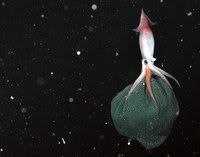
Mother squids of the Gonatus onyx species were found to lug around pouches of new eggs in their tentacles for up to six to nine months at a time, even though the load can weigh a quarter of their own weight and makes the mother slower and more vulnerable to predators, according to a study published in the Dec. 15 issue of the journal Nature."

Mother squids of the Gonatus onyx species were found to lug around pouches of new eggs in their tentacles for up to six to nine months at a time, even though the load can weigh a quarter of their own weight and makes the mother slower and more vulnerable to predators, according to a study published in the Dec. 15 issue of the journal Nature."
Labels:
squid
Wednesday, December 14, 2005
Dylan to Host XM Satellite Radio Show
"Bob Dylan will host a weekly music show on XM Satellite Radio, the first time the rock star has had his own radio show.
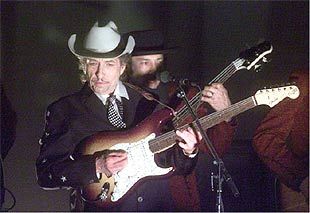
Dylan will select music for the hour-long show, which will debut in March on XM's deep album rock channel, the station announced Tuesday.
He'll also offer comments on music and other subjects, interview guests and answer e-mail from XM subscribers.
'Songs and music have always inspired me,' the 64-year-old Dylan said in a statement. 'A lot of my own songs have been played on the radio, but this is the first time I've ever been on the other side of the mic.'"

Dylan will select music for the hour-long show, which will debut in March on XM's deep album rock channel, the station announced Tuesday.
He'll also offer comments on music and other subjects, interview guests and answer e-mail from XM subscribers.
'Songs and music have always inspired me,' the 64-year-old Dylan said in a statement. 'A lot of my own songs have been played on the radio, but this is the first time I've ever been on the other side of the mic.'"
Labels:
dylan
Monday, December 12, 2005
Email to the Future
Although time travel technology doesn't exist yet that would enable a person to visit their future self, you can send an email to the person you will become via FutureMe.org, which lets you specify a date, up to 2035. Forbes.com recently ran a similar experiment, collecting email 'time capsules' to be sent out over the next 20 years.
As if we didn't have enough to do getting this year's Christmas cards done!
As if we didn't have enough to do getting this year's Christmas cards done!
Labels:
writing
Sunday, December 11, 2005
More Research Urged on Nanoparticle Risk
"Those stain-resistant khakis you just picked up at the mall, the tennis ball that holds its bounce longer and sunscreen that's clear instead of white have something in common - nanotechnology.
Scientists manipulating matter at the molecular level have improved on hundreds of everyday products in recent years and are promising dramatic breakthroughs in medicine and other industries as billions of dollars a year are pumped into the nascent sector.
But relatively little is known about the potential health and environmental effects of the tiny particles - just atoms wide and small enough to easily penetrate cells in lungs, brains and other organs.
While governments and businesses have begun pumping millions of dollars into researching such effects, scientists and others say nowhere near enough is being spent to determine whether nanomaterials pose a danger to human health."
Click the title to read the entire article
Scientists manipulating matter at the molecular level have improved on hundreds of everyday products in recent years and are promising dramatic breakthroughs in medicine and other industries as billions of dollars a year are pumped into the nascent sector.
But relatively little is known about the potential health and environmental effects of the tiny particles - just atoms wide and small enough to easily penetrate cells in lungs, brains and other organs.
While governments and businesses have begun pumping millions of dollars into researching such effects, scientists and others say nowhere near enough is being spent to determine whether nanomaterials pose a danger to human health."
Click the title to read the entire article
Friday, December 09, 2005
Earth's Magnetic Pole Drifting Quickly
"Earth's north magnetic pole is drifting away from North America and toward Siberia at such a clip that Alaska might lose its spectacular Northern Lights in the next 50 years, scientists said Thursday.
Despite accelerated movement over the past century, the possibility that Earth's modestly fading magnetic field will collapse is remote. But the shift could mean Alaska may no longer see the sky lights known as auroras, which might then be more visible in more southerly areas of Siberia and Europe.
The magnetic poles are part of the magnetic field generated by liquid iron in Earth's core and are different from the geographic poles, the surface points marking the axis of the planet's rotation.
Scientists have long known that magnetic poles migrate and in rare cases, swap places. Exactly why this happens is a mystery."
Despite accelerated movement over the past century, the possibility that Earth's modestly fading magnetic field will collapse is remote. But the shift could mean Alaska may no longer see the sky lights known as auroras, which might then be more visible in more southerly areas of Siberia and Europe.
The magnetic poles are part of the magnetic field generated by liquid iron in Earth's core and are different from the geographic poles, the surface points marking the axis of the planet's rotation.
Scientists have long known that magnetic poles migrate and in rare cases, swap places. Exactly why this happens is a mystery."
Thursday, December 08, 2005
Worming out of a problem in Australia
"On A patch of dairy country near Korumburra, a delicate and unprecedented operation has been taking place.
A group of threatened giant Gippsland earthworms, living in the path of a planned road, is being moved.
It is the first time scientists have tried to move an entire colony of the creatures, which can grow up to 1.5 metres long.
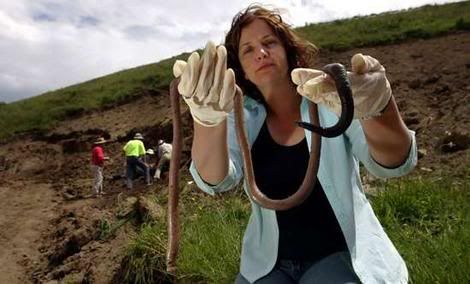
On the last day of the operation yesterday, the team declared their mission a success, having moved more than 600. However, there was a 20 per cent mortality rate."
A group of threatened giant Gippsland earthworms, living in the path of a planned road, is being moved.
It is the first time scientists have tried to move an entire colony of the creatures, which can grow up to 1.5 metres long.

On the last day of the operation yesterday, the team declared their mission a success, having moved more than 600. However, there was a 20 per cent mortality rate."
Pushing the envelope on love letters
"Love may be in the air but it is no longer in the mail, according to a new competition to revive the lost art of love letter writing.
Run for the first time last year in the United States when it attracted 5,000 entries, philanthropist Henri Zimand's competition to find the best written love letters has now opened to entrants from Britain as well.
'In this age of one-line e-mails and abbreviated text messages, the simple art of letter writing has all but been forgotten,' he said. 'Writing a love letter is a dying art and to me that is a real shame.'
The competition is dedicated to the memory of Zimand's wife Anda who died from breast cancer in 2003 aged 49.
'No one should underestimate the power of a letter that truly comes from the heart and with every letter I receive, I am moved, and remember my Anda,' Zimand said.
For each of the first 10,000 letters submitted to the website www.AndaSpirit.com in Britain or www.AndaSpiritUSA.com in the United States, Zimand will make a contribution to a cancer facility in the area where the letter originated.
If inspiration is needed, an example of one of last year's entries is as follows: 'Heartfelt and true, your beauty shines through, with love, emotion and everlasting devotion, I yearn to marry you.'
The winners -- to be selected by a panel including Zimand and judges from the Romance Writers of America -- will be flown to New York and, on the morning of St Valentine's Day, taken on a romantic horse-drawn carriage ride in the city."
Run for the first time last year in the United States when it attracted 5,000 entries, philanthropist Henri Zimand's competition to find the best written love letters has now opened to entrants from Britain as well.
'In this age of one-line e-mails and abbreviated text messages, the simple art of letter writing has all but been forgotten,' he said. 'Writing a love letter is a dying art and to me that is a real shame.'
The competition is dedicated to the memory of Zimand's wife Anda who died from breast cancer in 2003 aged 49.
'No one should underestimate the power of a letter that truly comes from the heart and with every letter I receive, I am moved, and remember my Anda,' Zimand said.
For each of the first 10,000 letters submitted to the website www.AndaSpirit.com in Britain or www.AndaSpiritUSA.com in the United States, Zimand will make a contribution to a cancer facility in the area where the letter originated.
If inspiration is needed, an example of one of last year's entries is as follows: 'Heartfelt and true, your beauty shines through, with love, emotion and everlasting devotion, I yearn to marry you.'
The winners -- to be selected by a panel including Zimand and judges from the Romance Writers of America -- will be flown to New York and, on the morning of St Valentine's Day, taken on a romantic horse-drawn carriage ride in the city."
Labels:
writing
Tuesday, December 06, 2005
After decades out of the limelight, `60s star seems to be everywhere
"Spying Donovan in the corridors at Sirius Satellite Radio in Manhattan is a bit like seeing one of those Japanese soldiers emerge from the jungles of the Philippines decades after the war has ended. He looks like a man disconnected from the flow of time.
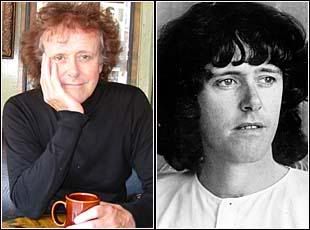
Forty years after the release of his first hit, "Catch the Wind," a song that vaulted folk music into the vanguard of pop, Donovan still cuts a pixieish figure, shoulder-length hair framing his creased yet boyish pug face. As he walks the hallway with a corkscrew gait, the remnant of a polio vaccine that withered his right leg as a boy in Glasgow, Scotland, he spritzes himself with a vial of floral essence.
Flower power is back. And this refugee from the '60s arrives with precious artifacts from that era: "Try for the Sun: The Journey of Donovan," a gaudily decorated four-disc career retrospective; "The Hurdy Gurdy Man," an effervescent autobiography; and a tour."

Forty years after the release of his first hit, "Catch the Wind," a song that vaulted folk music into the vanguard of pop, Donovan still cuts a pixieish figure, shoulder-length hair framing his creased yet boyish pug face. As he walks the hallway with a corkscrew gait, the remnant of a polio vaccine that withered his right leg as a boy in Glasgow, Scotland, he spritzes himself with a vial of floral essence.
Flower power is back. And this refugee from the '60s arrives with precious artifacts from that era: "Try for the Sun: The Journey of Donovan," a gaudily decorated four-disc career retrospective; "The Hurdy Gurdy Man," an effervescent autobiography; and a tour."
Monday, December 05, 2005
They can't believe it's Buddha
"Nepal's 'Buddha boy' is under investigation by the authorities, who question his claim not to have eaten anything for six months and are examining his followers' finances.
The government believes that Ram Bomjon, 15, may be breaking his fast to eat at night when his shrine is closed to visitors.
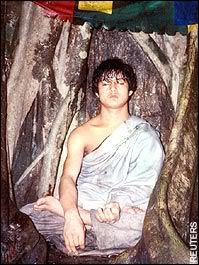
Buddhism experts, the interior ministry and Nepal's leading scientific agency have all been called in to investigate the phenomenon, which has attracted thousands of pilgrims and excitement worldwide.
"We told the shrine management committee, 'Either we need to see everything that is going on or, if this is a fraud, you need to close it down,' " said Hari Har Dahal, a local official. "This has got into the media all over the world. If it is not true, it will be bad for the country."
The way donations to the organising committee have been spent has also been questioned.
Hundreds of pilgrims were still entering the jungle near the village of Ratanpuri to see Ram this week, despite the authorities' attempts to discourage the faithful from visiting the site."
The government believes that Ram Bomjon, 15, may be breaking his fast to eat at night when his shrine is closed to visitors.

Buddhism experts, the interior ministry and Nepal's leading scientific agency have all been called in to investigate the phenomenon, which has attracted thousands of pilgrims and excitement worldwide.
"We told the shrine management committee, 'Either we need to see everything that is going on or, if this is a fraud, you need to close it down,' " said Hari Har Dahal, a local official. "This has got into the media all over the world. If it is not true, it will be bad for the country."
The way donations to the organising committee have been spent has also been questioned.
Hundreds of pilgrims were still entering the jungle near the village of Ratanpuri to see Ram this week, despite the authorities' attempts to discourage the faithful from visiting the site."
Labels:
buddha boy,
nepal
Friday, December 02, 2005
All the right moves for chess in America
"Chess in America is having a crisis. There were no American contenders in the recent world chess championship tournament in San Luis, Argentina, which was limited to the world's top eight players. The closest American candidate for the tournament was Hikaru Nakamura -- a 17-year-old who is ranked 42nd in the world. But Nakamura -- who at 15 became the youngest American grandmaster, breaking Bobby Fischer's record -- says that he might give up pro chess because there is so little money in it. Losing Nakamura would be devastating for American chess.
How can American chess save itself? No doubt it would make purists protest, but chess should steal a few moves from poker. After all, in the past few years, poker has lured away many chess masters who realized that the analytical skills they've learned from chess would pay off in online card rooms.
And that's a shame. There are plenty of smart people playing poker (and I love playing it myself), but there's no denying that when it comes to developing mental acuity, chess wins hands down, so to speak. Dan Harrington, a former world poker champion who quit chess because there wasn't enough money in it, laments that poker is thin and ephemeral in comparison."
Click on the title to read more, with suggestions for improving the marketability of chess
How can American chess save itself? No doubt it would make purists protest, but chess should steal a few moves from poker. After all, in the past few years, poker has lured away many chess masters who realized that the analytical skills they've learned from chess would pay off in online card rooms.
And that's a shame. There are plenty of smart people playing poker (and I love playing it myself), but there's no denying that when it comes to developing mental acuity, chess wins hands down, so to speak. Dan Harrington, a former world poker champion who quit chess because there wasn't enough money in it, laments that poker is thin and ephemeral in comparison."
Click on the title to read more, with suggestions for improving the marketability of chess
Labels:
chess
Thursday, December 01, 2005
Tuesday, November 29, 2005
Iowa Prof. Seeks Funding for 'Body Farm'
"Iowa's rich topsoil and climate have nourished some of the nation's most plentiful corn and soybean crops. Tyler O'Brien wants to learn more about their influence on rotting corpses.
A biological anthropology professor at the University of Northern Iowa, O'Brien envisions turning some prime Iowa pasture into a body farm, where human bodies - buried, stuffed in car trunks or exposed to the elements - can provide scholars and criminalists with new benchmark data on human decay.
'This idea has strong scientific value,' O'Brien said. 'To answer the question of how long a body has been dead, how long a person has been missing, is critical to criminal investigations.'
O'Brien is seeking a grant of $400,000 to $500,000 from the National Institute of Justice and other organizations to obtain the land and set up the project."
A biological anthropology professor at the University of Northern Iowa, O'Brien envisions turning some prime Iowa pasture into a body farm, where human bodies - buried, stuffed in car trunks or exposed to the elements - can provide scholars and criminalists with new benchmark data on human decay.
'This idea has strong scientific value,' O'Brien said. 'To answer the question of how long a body has been dead, how long a person has been missing, is critical to criminal investigations.'
O'Brien is seeking a grant of $400,000 to $500,000 from the National Institute of Justice and other organizations to obtain the land and set up the project."
Saturday, November 26, 2005
Row, row, row your boat?
"A man rowed -- yes, rowed! -- across the Pacific Ocean.
HIS face was tanned a reddish brown, and his eyes rimmed raccoon-style by white circles left by the shades that had sheltered them from a sun shining mercilessly over an open sea. His hands were terribly calloused and he had lost 9kg. But Emmanuel Coindre, rower extraordinaire, was in high spirits.
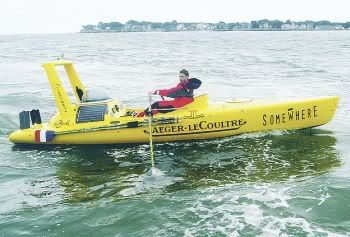
For over 129 days, he pitted his puny human strength against the might of the Pacific Ocean in a bid to complete a solo ocean crossing in record time, and he had accomplished his mission -- albeit not as he had originally planned. Coindre, 32, who cites his profession as “adventurer”, had set off from the port of Choshi in Japan on June 24 in a boat christened the Lady Inky"
HIS face was tanned a reddish brown, and his eyes rimmed raccoon-style by white circles left by the shades that had sheltered them from a sun shining mercilessly over an open sea. His hands were terribly calloused and he had lost 9kg. But Emmanuel Coindre, rower extraordinaire, was in high spirits.

For over 129 days, he pitted his puny human strength against the might of the Pacific Ocean in a bid to complete a solo ocean crossing in record time, and he had accomplished his mission -- albeit not as he had originally planned. Coindre, 32, who cites his profession as “adventurer”, had set off from the port of Choshi in Japan on June 24 in a boat christened the Lady Inky"
Wednesday, November 23, 2005
Scotsman.com News - Latest News - Bowie brings magic to new film role
"Rock idol David Bowie has landed a new movie role, playing the inventor and electrical genius Nikola Tesla.
Bowie, 58, will star alongside Hugh Jackman, Christian Bale and Michael Caine in forthcoming film The Prestige, according to movie industry magazine Variety.
Tesla is regarded as one of the greatest scientists in the history of technology and one of the most innovative engineers of the late 19th and early 20th centuries.
The Serbian electrical engineer, who became an American citizen, was hailed in his lifetime as a 'magician' who conjured up amazing technical feats.
The new thriller is based on a 1996 novel by Christopher Priest. In the film, Tesla is approached by one of two rival magicians in turn-of-the-century London for help in pulling off the ultimate magic trick.
The Prestige will be directed by Briton Christopher Nolan, whose previous films include Batman Begins.
Bowie's previous film roles have included parts in The Man Who Fell to Earth (1976), Merry Christmas, Mr Lawrence (1983), Basquiat (1996), and, most recently, Mr Rice's Secret (2000).
Bowie became friendly with Nolan when he wrote the tune Something In The Air for the close of Nolan's breakthrough film, Memento.
Filming will begin on The Prestige in January."
Bowie, 58, will star alongside Hugh Jackman, Christian Bale and Michael Caine in forthcoming film The Prestige, according to movie industry magazine Variety.
Tesla is regarded as one of the greatest scientists in the history of technology and one of the most innovative engineers of the late 19th and early 20th centuries.
The Serbian electrical engineer, who became an American citizen, was hailed in his lifetime as a 'magician' who conjured up amazing technical feats.
The new thriller is based on a 1996 novel by Christopher Priest. In the film, Tesla is approached by one of two rival magicians in turn-of-the-century London for help in pulling off the ultimate magic trick.
The Prestige will be directed by Briton Christopher Nolan, whose previous films include Batman Begins.
Bowie's previous film roles have included parts in The Man Who Fell to Earth (1976), Merry Christmas, Mr Lawrence (1983), Basquiat (1996), and, most recently, Mr Rice's Secret (2000).
Bowie became friendly with Nolan when he wrote the tune Something In The Air for the close of Nolan's breakthrough film, Memento.
Filming will begin on The Prestige in January."
Pilgrims flock to see 'Buddha boy' said to have fasted six months
"Thousands of pilgrims are pouring into the dense jungle of southern Nepal to worship a 15-year-old boy who has been hailed as a new Buddha.
Devotees claim that Ram Bomjon, who is silently meditating beneath a tree, has not eaten or drunk anything since he sat down at his chosen spot six months ago.

Witnesses say they have seen light emanating from the teenager's forehead.
"It looks a bit like when you shine a torch through your hand," said Tek Bahadur Lama, a member of the committee responsible for dealing with the growing number of visitors from India and elsewhere in Nepal.
The fervour increased last week when a snake is said to have bitten Ram, and a curtain was drawn around him.
After five days it was opened and he spoke. "Tell the people not to call me a Buddha. I don't have the Buddha's energy. I am at the level of rinpoche [lesser divinity].
"A snake bit me but I do not need treatment. I need six years of deep meditation.'"
Devotees claim that Ram Bomjon, who is silently meditating beneath a tree, has not eaten or drunk anything since he sat down at his chosen spot six months ago.

Witnesses say they have seen light emanating from the teenager's forehead.
"It looks a bit like when you shine a torch through your hand," said Tek Bahadur Lama, a member of the committee responsible for dealing with the growing number of visitors from India and elsewhere in Nepal.
The fervour increased last week when a snake is said to have bitten Ram, and a curtain was drawn around him.
After five days it was opened and he spoke. "Tell the people not to call me a Buddha. I don't have the Buddha's energy. I am at the level of rinpoche [lesser divinity].
"A snake bit me but I do not need treatment. I need six years of deep meditation.'"
Labels:
buddha boy,
nepal
Tuesday, November 22, 2005
To the Moon, Alice! (Use Your Internet Connection, Dear)
"Imagine soaring over the surface of the Moon, dipping into a crater and seeing rock slides on its slopes and boulders piled up at the bottom.

Closeups of the crater Tycho
You don't have to wait for a spaceship or even the night sky to get such a close-up view of the Moon. You can visit it now with a PC and a broadband Internet connection, courtesy of a free public-access program developed by the National Aeronautics and Space Administration's Ames Research Center in California.
Users must have a high-speed, broadband Internet connection and a computer running Windows 2000 or XP. World Wind can be downloaded at worldwind.arc.nasa.gov.
Users of the public program have produced a Web site that provides instructions and help, as well as applications that use the World Wind data, such as an add-on program that makes it easier to find spots like the Apollo landing sites, Mr. Hogan said.
These features and help are online at worldwindcentral.com."

Closeups of the crater Tycho
You don't have to wait for a spaceship or even the night sky to get such a close-up view of the Moon. You can visit it now with a PC and a broadband Internet connection, courtesy of a free public-access program developed by the National Aeronautics and Space Administration's Ames Research Center in California.
Users must have a high-speed, broadband Internet connection and a computer running Windows 2000 or XP. World Wind can be downloaded at worldwind.arc.nasa.gov.
Users of the public program have produced a Web site that provides instructions and help, as well as applications that use the World Wind data, such as an add-on program that makes it easier to find spots like the Apollo landing sites, Mr. Hogan said.
These features and help are online at worldwindcentral.com."
Saturday, November 19, 2005
New Domino Record
The organizers of Domino Day 2005 managed to set a new world record Friday after successfully toppling more than 4.1 million dominoes. Their record-breaking attempt nearly ended earlier this week, however, when a sparrow flew through an open window in the auditorium and knocked down 23,000 dominoes. A system of 750 safety blocks prevented the bird from bringing down most of the domino chain.

View 3 pages of incredible images from the event at dominodomain.com:
Page 1, Page 2 and Page 3

View 3 pages of incredible images from the event at dominodomain.com:
Page 1, Page 2 and Page 3
NASA - Space-time Vortex
"Is Earth in a vortex of space-time?
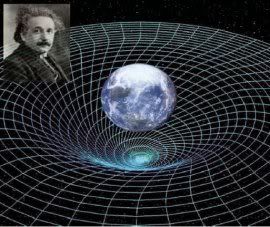
We'll soon know the answer: A NASA/Stanford physics experiment called Gravity Probe B (GP-B) recently finished a year of gathering science data in Earth orbit. The results, which will take another year to analyze, should reveal the shape of space-time around Earth--and, possibly, the vortex."
Click on the title to read the entire article.

We'll soon know the answer: A NASA/Stanford physics experiment called Gravity Probe B (GP-B) recently finished a year of gathering science data in Earth orbit. The results, which will take another year to analyze, should reveal the shape of space-time around Earth--and, possibly, the vortex."
Click on the title to read the entire article.
Dylan snubs British music hall of fame
"LONDON: Rock legend Bob Dylan has upset organisers of the British Music Hall Of Fame by refusing to show up or make a video acceptance speech.
Dylan refused to appear at the event despite the organisers having to reschedule the ceremony to coincide with Dylan's Britain tour, reported Contactmusic.com.
Woddy Harrelson, an acquaintance of Dylan, accepted the award on his behalf. An organiser said: 'We made every effort to get him to accept it in person or with a video message, but he obviously prefers to remain as enigmatic as ever.'"
Dylan refused to appear at the event despite the organisers having to reschedule the ceremony to coincide with Dylan's Britain tour, reported Contactmusic.com.
Woddy Harrelson, an acquaintance of Dylan, accepted the award on his behalf. An organiser said: 'We made every effort to get him to accept it in person or with a video message, but he obviously prefers to remain as enigmatic as ever.'"
Labels:
dylan
Friday, November 18, 2005
The show goes on for Stephen Hawking
"When you're recounting the drama of cosmic origins, the show must go on -- even if you're a quadriplegic recovering from a medical crisis.

Wednesday's appearance at the Paramount Theatre — presented by the Oregon-based Institute for Science, Engineering and Public Policy, or ISEPP — was the last of three scheduled stops on the Cambridge professor's U.S. lecture tour. Hawking, who suffers from a progressive neurodegenerative disease that has almost completely paralyzed him, was due to travel to Seattle from San Francisco. But when he was taken off his respirator Monday morning, "he basically flat-lined," said Terry Bristol, ISEPP's president and executive director.
"They had to resuscitate, and that panicked a few people," Bristol told the audience. "But he's been there before."
Once the crisis had passed, Hawking wanted to go ahead with the Seattle leg of the trip, but his medical caretakers — including his wife, Elaine — thought he should stay put awhile longer, Bristol said. So Hawking and his aides worked with Intel, ISEPP and the Paramount to set up a Web-based teleconferencing link from a Bay Area hotel.
Despite the teleconferenced video and the flat tone of Hawking's synthesized computer voice, his outspokenness and humor shone through as lively as ever. The highlight was a recap of Hawking's favorite answers to frequently asked questions — some of which drew so much applause from the Seattle crowd that Bristol, the master of ceremonies, occasionally had to repeat the answers. Some examples:
What did he think of "The Simpsons" TV show, which has had Hawking as an animated guest star? "It's the best thing on American TV."
What was his view of the Bush administration's limits on human embryonic stem-cell research: "America will be left behind if it doesn't change policy."
What did he think of the program to send American astronauts back to the moon? "Stupid," he answered. "Sending politicians would be much cheaper, because you don't have to bring them back."
How high is Hawking's IQ? The physicist replied that he didn't know. "People who boast about their IQ are losers," he said.
Which late personage would he rather meet, Isaac Newton or Marilyn Monroe? "Marilyn," Hawking said. "Newton seems to have been an unpleasant character.'"

Wednesday's appearance at the Paramount Theatre — presented by the Oregon-based Institute for Science, Engineering and Public Policy, or ISEPP — was the last of three scheduled stops on the Cambridge professor's U.S. lecture tour. Hawking, who suffers from a progressive neurodegenerative disease that has almost completely paralyzed him, was due to travel to Seattle from San Francisco. But when he was taken off his respirator Monday morning, "he basically flat-lined," said Terry Bristol, ISEPP's president and executive director.
"They had to resuscitate, and that panicked a few people," Bristol told the audience. "But he's been there before."
Once the crisis had passed, Hawking wanted to go ahead with the Seattle leg of the trip, but his medical caretakers — including his wife, Elaine — thought he should stay put awhile longer, Bristol said. So Hawking and his aides worked with Intel, ISEPP and the Paramount to set up a Web-based teleconferencing link from a Bay Area hotel.
Despite the teleconferenced video and the flat tone of Hawking's synthesized computer voice, his outspokenness and humor shone through as lively as ever. The highlight was a recap of Hawking's favorite answers to frequently asked questions — some of which drew so much applause from the Seattle crowd that Bristol, the master of ceremonies, occasionally had to repeat the answers. Some examples:
What did he think of "The Simpsons" TV show, which has had Hawking as an animated guest star? "It's the best thing on American TV."
What was his view of the Bush administration's limits on human embryonic stem-cell research: "America will be left behind if it doesn't change policy."
What did he think of the program to send American astronauts back to the moon? "Stupid," he answered. "Sending politicians would be much cheaper, because you don't have to bring them back."
How high is Hawking's IQ? The physicist replied that he didn't know. "People who boast about their IQ are losers," he said.
Which late personage would he rather meet, Isaac Newton or Marilyn Monroe? "Marilyn," Hawking said. "Newton seems to have been an unpleasant character.'"
Labels:
stephen hawking
Wednesday, November 16, 2005
Harriet the tortoise turns 175
"One of the world's oldest living animals, Harriet the tortoise, celebrated her 175th birthday on Tuesday -- with a pink hibiscus flower cake at her retirement home in northern Australia.
Australia Zoo, where Harriet has spent the past 17 years, says the Giant Galapagos Land Tortoise was collected by scientist Charles Darwin in 1835, although some historians have disputed this.
There is no doubt however over the age of Harriet -- who for more than a century was thought to be a male and named Harry -- and she is recognised by Guinness World Records as the world's oldest living chelonian, or reptile with a shell of bony plates.
"She would definitely be the oldest living animal on Earth ... I can't see why she shouldn't live till 200," Australian conservationist and television celebrity Steve Irwin, who owns Australia Zoo north of the city of Brisbane, told Guinness World Records."
Australia Zoo, where Harriet has spent the past 17 years, says the Giant Galapagos Land Tortoise was collected by scientist Charles Darwin in 1835, although some historians have disputed this.
There is no doubt however over the age of Harriet -- who for more than a century was thought to be a male and named Harry -- and she is recognised by Guinness World Records as the world's oldest living chelonian, or reptile with a shell of bony plates.
"She would definitely be the oldest living animal on Earth ... I can't see why she shouldn't live till 200," Australian conservationist and television celebrity Steve Irwin, who owns Australia Zoo north of the city of Brisbane, told Guinness World Records."
Tuesday, November 15, 2005
Mysterious Runaway Star Stymies Scientist
"Astronomers have stumbled onto a runaway star inbound to our galaxy that might have been kicked out of our nearest galactic neighbor by a supermassive black hole.

The star, HE 0437-5439, was found on a star survey and initially led its discoverers to suspect their instruments were out of whack.
'We first thought our wavelength calibration was off,' said astronomer Ralf Napiwotzki of the University of Hertfordshire's Center for Astrophysics Research in the U.K.
The light from the star was both the wrong color (wavelength) for where the star is located and showed spectral signs that it is traveling inbound to the Milky Way at an unusually high speed -- about 1.6 million miles per hour (2.6 million kilometers per hour). "

The star, HE 0437-5439, was found on a star survey and initially led its discoverers to suspect their instruments were out of whack.
'We first thought our wavelength calibration was off,' said astronomer Ralf Napiwotzki of the University of Hertfordshire's Center for Astrophysics Research in the U.K.
The light from the star was both the wrong color (wavelength) for where the star is located and showed spectral signs that it is traveling inbound to the Milky Way at an unusually high speed -- about 1.6 million miles per hour (2.6 million kilometers per hour). "
Saturday, November 12, 2005
Enormous nuclear bunker for sale
"A nuclear bunker made to house the government and civil servants in the event of nuclear attack is for sale.

The existence of the underground complex at Corsham, Wiltshire, was kept secret until recently, but the Ministry of Defence is now inviting buyers.
Built in the late 1950s, the bunker covers many acres and was decommissioned in the 1980s.
It is underground - more than 100ft (30m) down - and includes a kitchen and BBC studio. "

The existence of the underground complex at Corsham, Wiltshire, was kept secret until recently, but the Ministry of Defence is now inviting buyers.
Built in the late 1950s, the bunker covers many acres and was decommissioned in the 1980s.
It is underground - more than 100ft (30m) down - and includes a kitchen and BBC studio. "
Thursday, November 10, 2005
Israelite Alphabet May Have Been Found
"Two lines of an alphabet have been found inscribed in a stone in Israel, offering what some scholars say is the most solid evidence yet that the ancient Israelites were literate as early as the 10th century B.C.
'This is very rare. This stone will be written about for many years to come,' archaeologist Ron E. Tappy, a professor at the Pittsburgh Theological Seminary who made the discovery, said Wednesday. 'This makes it very historically probable there were people in the 10th century (B.C.) who could write.'
Christopher Rollston, a professor of Semitic studies at Emmanuel School of Religion in Johnson City, Tenn., who was not involved in the find, said the writing is probably Phoenician or a transitional language between Phoenician and Hebrew.
"We have little epigraphic material from the 10th century in Israel, and so this substantially augments the material we have," he said.
The stone was found in July, on the final day of a five-week dig at Tel Zayit, about 30 miles south of Tel Aviv."
'This is very rare. This stone will be written about for many years to come,' archaeologist Ron E. Tappy, a professor at the Pittsburgh Theological Seminary who made the discovery, said Wednesday. 'This makes it very historically probable there were people in the 10th century (B.C.) who could write.'
Christopher Rollston, a professor of Semitic studies at Emmanuel School of Religion in Johnson City, Tenn., who was not involved in the find, said the writing is probably Phoenician or a transitional language between Phoenician and Hebrew.
"We have little epigraphic material from the 10th century in Israel, and so this substantially augments the material we have," he said.
The stone was found in July, on the final day of a five-week dig at Tel Zayit, about 30 miles south of Tel Aviv."
Tuesday, November 08, 2005
Grand Canyon to Get Glass Bridge
"Fear of heights? This is definitely no place for you.

The all-glass, balcony-like 'Skywalk'--shown in an illustration released this week--will extend over the edge of the Grand Canyon, 4,000 feet (1,200 meters) above the Colorado River.
'The Skywalk will be an attraction unlike any other in the world,' said Sheri Yellowhawk, CEO of the Grand Canyon Resort Corporation. The company is building the bridge in the Hualapai Indian Reservation on the south rim of the canyon.
The Skywalk is scheduled to open to the public in January 2006 as part of a new resort on the reservation. The resort, known as Grand Canyon West, is to include a re-created Indian village and a restaurant perched on the edge of the canyon. Tourism is the reservation's biggest source of income.
Grand Canyon West will be on the western edge of Grand Canyon National Park, about 120 miles (about 200 kilometers) from Las Vegas. But perhaps not even the Las Vegas Strip's over-the-top attractions will be a match for this glass-bottom walkway over the world's biggest gorge."

The all-glass, balcony-like 'Skywalk'--shown in an illustration released this week--will extend over the edge of the Grand Canyon, 4,000 feet (1,200 meters) above the Colorado River.
'The Skywalk will be an attraction unlike any other in the world,' said Sheri Yellowhawk, CEO of the Grand Canyon Resort Corporation. The company is building the bridge in the Hualapai Indian Reservation on the south rim of the canyon.
The Skywalk is scheduled to open to the public in January 2006 as part of a new resort on the reservation. The resort, known as Grand Canyon West, is to include a re-created Indian village and a restaurant perched on the edge of the canyon. Tourism is the reservation's biggest source of income.
Grand Canyon West will be on the western edge of Grand Canyon National Park, about 120 miles (about 200 kilometers) from Las Vegas. But perhaps not even the Las Vegas Strip's over-the-top attractions will be a match for this glass-bottom walkway over the world's biggest gorge."
Saturday, November 05, 2005
Shave Your Yeti

For those of you who have always wanted to shave an Abominable Snowman, or Yeti (and really, who hasn't), now's your chance. Just click on the title link above if you already have Macromedia Flash installed on your computer. If not, it's a free download here.
Make sure you shave him completely!
New bird flu outbreaks hit Asia
"China and Vietnam have reported major new bird flu outbreaks, as Japan moved to cull 180,000 chickens at a farm where signs of the virus were found.
The lethal H5N1 virus killed nearly 9,000 chickens in China's Liaoning province and 3,000 birds in Bac Giang province in Vietnam, officials said.
Japanese officials said tests showed 80 chickens in Ibaraki had been exposed in the past to a virus from the H5 family. But the chickens had survived, and no active virus was found.
Further tests are needed to identify its exact strain.
The H5N1 virus has killed millions of birds across Asia, and millions more have been culled in an effort to stem the spread of the virus. At least 60 people have also died of the disease, since its resurgence at the end of 2003. There are fears the virus could mutate into a form that passes easily between people.

China's new outbreak - the fourth in three weeks - occurred on 26 October, the agriculture ministry said in a report posted on the website of the World Organisation for Animal Health."
The lethal H5N1 virus killed nearly 9,000 chickens in China's Liaoning province and 3,000 birds in Bac Giang province in Vietnam, officials said.
Japanese officials said tests showed 80 chickens in Ibaraki had been exposed in the past to a virus from the H5 family. But the chickens had survived, and no active virus was found.
Further tests are needed to identify its exact strain.
The H5N1 virus has killed millions of birds across Asia, and millions more have been culled in an effort to stem the spread of the virus. At least 60 people have also died of the disease, since its resurgence at the end of 2003. There are fears the virus could mutate into a form that passes easily between people.

China's new outbreak - the fourth in three weeks - occurred on 26 October, the agriculture ministry said in a report posted on the website of the World Organisation for Animal Health."
Tuesday, November 01, 2005
Pluto found to have two more moons
"Two small moons have been discovered orbiting Pluto, bringing the planet's retinue of known satellites to three and leaving scientists to wonder how it could be.

The newfound moons orbit about 27,000 miles (44,000 kilometers) from Pluto, more than twice as far as Charon, Pluto's other satellite. They are 5,000 times dimmer than Charon."

The newfound moons orbit about 27,000 miles (44,000 kilometers) from Pluto, more than twice as far as Charon, Pluto's other satellite. They are 5,000 times dimmer than Charon."
Labels:
pluto
On Gravity, Oreos and a Theory of Everything - New York Times
"The portal to the fifth dimension, sadly, is closed.
There used to be an ice cream parlor in the student center at the Massachusetts Institute of Technology. And it was there, in the summer of 1998, that Lisa Randall, now a professor of physics at Harvard and a bit of a chocoholic, and Raman Sundrum, a professor at Johns Hopkins, took an imaginary trip right out of this earthly plane into a science fiction realm of parallel universes, warped space and otherworldly laws of physics.
They came back with a possible answer to a question that has tormented scientists for decades, namely why gravity is so weak compared with the other forces of nature: in effect, we are borrowing it from another universe. In so doing, Dr. Randall and Dr. Sundrum helped foment a revolution in the way scientists think about string theory - the vaunted 'theory of everything' - raising a glimmer of hope that coming experiments may actually test some of its ineffable sounding concepts.
Their work undermined well-worn concepts like the idea that we can even know how many dimensions of space we live in, or the reality of gravity, space and time.

The work has also made a star and an icon of Dr. Randall. The attention has been increased by the recent publication to laudatory reviews of her new book, 'Warped Passages, Unraveling the Mysteries of the Universe's Hidden Dimensions,' A debate broke out on the physics blog Cosmic Variance a few weeks ago about whether it was appropriate, as a commentator on NPR had said, to say looked like Jodie Foster."
There used to be an ice cream parlor in the student center at the Massachusetts Institute of Technology. And it was there, in the summer of 1998, that Lisa Randall, now a professor of physics at Harvard and a bit of a chocoholic, and Raman Sundrum, a professor at Johns Hopkins, took an imaginary trip right out of this earthly plane into a science fiction realm of parallel universes, warped space and otherworldly laws of physics.
They came back with a possible answer to a question that has tormented scientists for decades, namely why gravity is so weak compared with the other forces of nature: in effect, we are borrowing it from another universe. In so doing, Dr. Randall and Dr. Sundrum helped foment a revolution in the way scientists think about string theory - the vaunted 'theory of everything' - raising a glimmer of hope that coming experiments may actually test some of its ineffable sounding concepts.
Their work undermined well-worn concepts like the idea that we can even know how many dimensions of space we live in, or the reality of gravity, space and time.

The work has also made a star and an icon of Dr. Randall. The attention has been increased by the recent publication to laudatory reviews of her new book, 'Warped Passages, Unraveling the Mysteries of the Universe's Hidden Dimensions,' A debate broke out on the physics blog Cosmic Variance a few weeks ago about whether it was appropriate, as a commentator on NPR had said, to say looked like Jodie Foster."
Study: Mice Sing in the Presence of Mates
"Songbirds may be the Sinatras of the animal world, but male mice can carry a tune too, say Washington University researchers who were surprised by what they heard.
Scientists have known for decades that male lab mice produce high-frequency sounds - undetectable by human ears - when they pick up the scent of a female mouse. This high-pitched babble is presumably for courtship, although scientists are not certain.
But it turns out those sounds are more complex and interesting than previously thought.
'It soon became ... apparent that these vocalizations were not random twitterings but songs,' said researcher Timothy Holy. 'There was a pattern to them. They sounded a lot like bird songs.'"
Scientists have known for decades that male lab mice produce high-frequency sounds - undetectable by human ears - when they pick up the scent of a female mouse. This high-pitched babble is presumably for courtship, although scientists are not certain.
But it turns out those sounds are more complex and interesting than previously thought.
'It soon became ... apparent that these vocalizations were not random twitterings but songs,' said researcher Timothy Holy. 'There was a pattern to them. They sounded a lot like bird songs.'"
Saturday, October 29, 2005
Nobel Laureate Richard Smalley, 62, Dies
"Nobel Laureate Richard Smalley, a Rice University professor who helped discover buckyballs, the soccer ball-shaped form of carbon, and championed the field of nanotechnology, has died at the age of 62.
Smalley, who had battled cancer, died Friday at M.D. Anderson Cancer Center, Rice University said.
'We will miss Rick's brilliance, commitment, energy, enthusiasm and humanity,' Rice President David Leebron said.
He shared the 1996 Nobel Prize in chemistry with fellow Rice chemist Robert Curl and British chemist Sir Harold Kroto for the discovery of the new form of carbon, which they dubbed buckminsterfullerene - buckyballs for short - because of its resemblance to the geodesic domes designed by Buckminster Fuller."
See my link at left to 'Everything I Know' and Buckminster Fuller. Also, 'Heroes Still', listed under the Essays section, also on the left.
Smalley, who had battled cancer, died Friday at M.D. Anderson Cancer Center, Rice University said.
'We will miss Rick's brilliance, commitment, energy, enthusiasm and humanity,' Rice President David Leebron said.
He shared the 1996 Nobel Prize in chemistry with fellow Rice chemist Robert Curl and British chemist Sir Harold Kroto for the discovery of the new form of carbon, which they dubbed buckminsterfullerene - buckyballs for short - because of its resemblance to the geodesic domes designed by Buckminster Fuller."
See my link at left to 'Everything I Know' and Buckminster Fuller. Also, 'Heroes Still', listed under the Essays section, also on the left.
Friday, October 28, 2005
The Norman Transcript--Typewritten words
"The history of the typewritten word is a lesson in clumsy marketing, society's changing values and America's economic cycles over the past 150 years.
Much of it is on display at Copelin's Office Center, 425 W. Main, St. where old, black typewriter specimens looking more like industrial machines than office appliances squat on glass shelves. Had they been equipped with the memory and storage functions of today's computers, they might well tell us something of their owners and users, long since gone."
Any newspaper named 'The Norman Transcript' has to be good. This is an interesting article about the history of typewriters, with even a mention of fountain pens:
"Ed Copelin, owner of the office supply business for 22 years, said he has been “haphazardly” collecting antique typewriters, adding machines and cash registers for about half that time.
Copelin said he has the fortune of many old friends who donated their office machines over the years. He decided to exhibit the antiquated typewriters “because they’re reflective of the business I’m in.”
He also has an extensive fountain pen collection and hosts a fountain pen show every few years. Collectors use the show to buy, sell and trade writing instruments."
Much of it is on display at Copelin's Office Center, 425 W. Main, St. where old, black typewriter specimens looking more like industrial machines than office appliances squat on glass shelves. Had they been equipped with the memory and storage functions of today's computers, they might well tell us something of their owners and users, long since gone."
Any newspaper named 'The Norman Transcript' has to be good. This is an interesting article about the history of typewriters, with even a mention of fountain pens:
"Ed Copelin, owner of the office supply business for 22 years, said he has been “haphazardly” collecting antique typewriters, adding machines and cash registers for about half that time.
Copelin said he has the fortune of many old friends who donated their office machines over the years. He decided to exhibit the antiquated typewriters “because they’re reflective of the business I’m in.”
He also has an extensive fountain pen collection and hosts a fountain pen show every few years. Collectors use the show to buy, sell and trade writing instruments."
Labels:
typewriter,
writing
Thursday, October 27, 2005
Man's Best Friend Is Pretty Smart
A very interesting article on canine intelligence...even comparing domesticated dogs to wolves...and how that intelligence may differ.
"After a decade studying dogs in their human habitat, Mr. Miklosi and his colleagues have accumulated a body of evidence suggesting that dogs have far greater mental capabilities than scientists had thought. "
"After a decade studying dogs in their human habitat, Mr. Miklosi and his colleagues have accumulated a body of evidence suggesting that dogs have far greater mental capabilities than scientists had thought. "
Labels:
dog,
intelligence
Monday, October 24, 2005
Researchers all but zap ancient death ray myth
"SAN FRANCISCO - It wasn't exactly the ancient siege of Syracuse, but rather a curious quest for scientific validation.
According to sparse historical writings, the Greek mathematician Archimedes torched a fleet of invading Roman ships by reflecting the sun's powerful rays with a mirrored device made of glass or bronze.
More than 2,000 years later, researchers from the Massachusetts Institute of Technology and the University of Arizona set out to recreate Archimedes' fabled death ray Saturday in an experiment sponsored by the Discovery Channel program 'MythBusters.'"
According to sparse historical writings, the Greek mathematician Archimedes torched a fleet of invading Roman ships by reflecting the sun's powerful rays with a mirrored device made of glass or bronze.
More than 2,000 years later, researchers from the Massachusetts Institute of Technology and the University of Arizona set out to recreate Archimedes' fabled death ray Saturday in an experiment sponsored by the Discovery Channel program 'MythBusters.'"
Saturday, October 22, 2005
E-Tutoring Broadens Bounds of Outsourcing
"Oct 22, 5:59 PM (ET)
By NIRMALA GEORGE and MARTHA IRVINE
COCHIN, India (AP) - A few stars are still twinkling in the inky pre-dawn sky when Koyampurath Namitha arrives for work in a quiet suburb of this south Indian city. It's barely 4:30 a.m. when she grabs a cup of coffee and joins more than two dozen colleagues, each settling into a cubicle with a computer and earphones.
More than 7,000 miles away, in Glenview, Ill., outside Chicago, it's the evening of the previous day and 14-year-old Princeton John sits at his computer, barefoot and ready for his hourlong geometry lesson. The high school freshman puts on a headset with a microphone and clicks on computer software that will link him through the Internet to his tutor, Namitha, many time zones away.
It's called e-tutoring - yet another example of how modern communications, and an abundance of educated, low-wage Asians, are broadening the boundaries of outsourcing and working their way into the minutiae of American life, from replacing your lost credit card through reading your CAT scan to helping you revive your crashed computer."
By NIRMALA GEORGE and MARTHA IRVINE
COCHIN, India (AP) - A few stars are still twinkling in the inky pre-dawn sky when Koyampurath Namitha arrives for work in a quiet suburb of this south Indian city. It's barely 4:30 a.m. when she grabs a cup of coffee and joins more than two dozen colleagues, each settling into a cubicle with a computer and earphones.
More than 7,000 miles away, in Glenview, Ill., outside Chicago, it's the evening of the previous day and 14-year-old Princeton John sits at his computer, barefoot and ready for his hourlong geometry lesson. The high school freshman puts on a headset with a microphone and clicks on computer software that will link him through the Internet to his tutor, Namitha, many time zones away.
It's called e-tutoring - yet another example of how modern communications, and an abundance of educated, low-wage Asians, are broadening the boundaries of outsourcing and working their way into the minutiae of American life, from replacing your lost credit card through reading your CAT scan to helping you revive your crashed computer."
Wednesday, October 19, 2005
Peru's ancient lines face 21st-century threats
"NAZCA, Peru - A tiny, hand-painted sign mounted on a flimsy barbed wire fence warns visitors to Peru's Nazca lines: "No entry. Area off-limits".
It's not much of a deterrent.
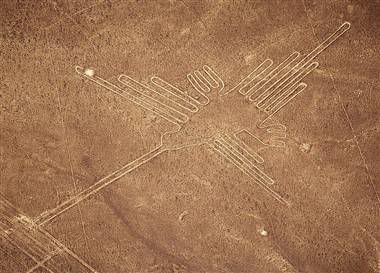
The latest threat to the vast U.N. World Heritage site, where enigmatic shapes and lines, stylized figures of birds and animals were etched in the desert 2,000 years ago, is a camp of around 30 shacks that appeared in August."
It's not much of a deterrent.

The latest threat to the vast U.N. World Heritage site, where enigmatic shapes and lines, stylized figures of birds and animals were etched in the desert 2,000 years ago, is a camp of around 30 shacks that appeared in August."
Navy Sued Over Harm to Whales From Mid-Frequency Sonar
"LOS ANGELES (October 19, 2005) -- Ear-splitting sonar used throughout the world's oceans during routine testing and training by the United States Navy harms marine mammals in violation of bedrock environmental laws, according to a lawsuit filed here today in federal court. Whales, dolphins and other marine animals could be spared excruciating injury and death with common sense precautions, but the Navy refuses to implement them, according to the lawsuit, brought by a coalition of conservation and animal welfare organizations led by the Natural Resources Defense Council (NRDC).

Mid-frequency sonar can emit continuous sound well above 235 decibels, an intensity roughly comparable to a Saturn V rocket at blastoff. Marine mammals have extraordinarily sensitive hearing, and there is no scientific dispute that intense sonar blasts can disturb, injure, and even kill them. Whales exposed to high-intensity mid-frequency sonar have repeatedly stranded and died on beaches around the world; some bleeding from the eyes and ears, with severe lesions in their organ tissue. At lower intensities, sonar can interfere with the ability of marine mammals to navigate, avoid predators, find food, care for their young, and, ultimately, to survive.
Mass stranding and mortality events associated with mid-frequency sonar exercises have occurred, among other places, in North Carolina (2005); Haro Strait off the coast of Washington State (2003); the Canary Islands (2004, 2002, 1989, 1986, 1985); Madeira (2000); the U.S. Virgin Islands (1999, 1998); and in Greece (1996). One of the best documented incidents occurred in the Bahamas in 2000 when 16 whales of three species stranded along 150 miles of shoreline as ships blasted the area with sonar. The U.S. Navy later acknowledged in an official report that its use of sonar was the likely cause of the stranding.
The association between sonar and whale mortalities is "very convincing and appears overwhelming," according to a report issued last year by the scientific committee of the International Whaling Commission, one of the world's leading bodies of whale biologists. The committee also noted concerns that stranding reports may underestimate sonar harm because they do not account for whales that die at sea and are never found."

Mid-frequency sonar can emit continuous sound well above 235 decibels, an intensity roughly comparable to a Saturn V rocket at blastoff. Marine mammals have extraordinarily sensitive hearing, and there is no scientific dispute that intense sonar blasts can disturb, injure, and even kill them. Whales exposed to high-intensity mid-frequency sonar have repeatedly stranded and died on beaches around the world; some bleeding from the eyes and ears, with severe lesions in their organ tissue. At lower intensities, sonar can interfere with the ability of marine mammals to navigate, avoid predators, find food, care for their young, and, ultimately, to survive.
Mass stranding and mortality events associated with mid-frequency sonar exercises have occurred, among other places, in North Carolina (2005); Haro Strait off the coast of Washington State (2003); the Canary Islands (2004, 2002, 1989, 1986, 1985); Madeira (2000); the U.S. Virgin Islands (1999, 1998); and in Greece (1996). One of the best documented incidents occurred in the Bahamas in 2000 when 16 whales of three species stranded along 150 miles of shoreline as ships blasted the area with sonar. The U.S. Navy later acknowledged in an official report that its use of sonar was the likely cause of the stranding.
The association between sonar and whale mortalities is "very convincing and appears overwhelming," according to a report issued last year by the scientific committee of the International Whaling Commission, one of the world's leading bodies of whale biologists. The committee also noted concerns that stranding reports may underestimate sonar harm because they do not account for whales that die at sea and are never found."
Tuesday, October 18, 2005
Tool-using gorillas intrigue scientists
It seems that scientists haven't kept up with the observed behavior of Koko, Michael and Ndume at Penny Patterson's Gorilla Foundation over the past 30 years, if they are surprised by gorilla tool use!
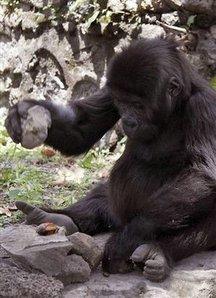
"GOMA, Congo - An infant gorilla in a Congo sanctuary is smashing palm nuts between two rocks to extract oil, surprising and intriguing scientists who say they have much to learn about what gorillas can do — and about the implications for evolution.It had been thought that the premeditated use of stones and sticks to accomplish a task like cracking nuts was restricted to humans and the smaller, more agile chimpanzees.
Then in late September, keepers at a Dian Fossey Gorilla Fund International sanctuary in this eastern Congo city saw 2 1/2-year-old female gorilla Itebero smashing palm nuts between rocks in the "hammer and anvil" technique, considered among the most complex tool use behaviors.
"This is a surprising finding, given what we know about tool use in gorillas," Patrick Mehlman, a primatologist for the Dian Fossey Gorilla Fund, said earlier this month at his Goma office."

"GOMA, Congo - An infant gorilla in a Congo sanctuary is smashing palm nuts between two rocks to extract oil, surprising and intriguing scientists who say they have much to learn about what gorillas can do — and about the implications for evolution.It had been thought that the premeditated use of stones and sticks to accomplish a task like cracking nuts was restricted to humans and the smaller, more agile chimpanzees.
Then in late September, keepers at a Dian Fossey Gorilla Fund International sanctuary in this eastern Congo city saw 2 1/2-year-old female gorilla Itebero smashing palm nuts between rocks in the "hammer and anvil" technique, considered among the most complex tool use behaviors.
"This is a surprising finding, given what we know about tool use in gorillas," Patrick Mehlman, a primatologist for the Dian Fossey Gorilla Fund, said earlier this month at his Goma office."

Labels:
ape,
gorilla,
intelligence
Saturday, October 15, 2005
A fountain pen for Gandhi: The story of a celebrated pen
"Great Indians ranging from Mahatma Gandhi to Indira Gandhi, Rajendra Prasad to Shankar Dayal Sharma, S. Kasturiranga Iyengar of The Hindu to Ramnath Goenka of Indian Express, had one thing in common: they used pens supplied from this town in coastal Andhra Pradesh. Ratnam pens, known as `swadeshi' pens, during the freedom movement, brought laurels to Rajahmundry and the pen-maker K.V. Ratnam.

The pen has many unique features. And you can order one of your choice.
During the swadeshi movement, after Gandhiji gave a call to boycott foreign goods, Ratnam, who was until then involved in making lithographic blocks, met Gandhiji in 1921. Gandhiji advised him to make something that would be useful to the common man and that was inexpensive.
Ratnam and his brother, basically goldsmiths, made a golden nib and presented it to a sub-judge who needed it. Then in 1932, Nyapati Subba Rao Pantulu, one of the founders of The Hindu, ordered the first pen. It was made of silver.
Nyapati Subba Rao (Junior), a grandson of Subba Rao Pantulu, said: 'It is true that the first pen was purchased by my grandfather. He used only Ratnam pens. They were made to order and gifted to VIPs visiting Rajahmundry. I was told that my grandfather personally delivered Ratnam pens to Sri Kasturiranga Iyengar several times.'
One for Gandhiji
Ratnam made a pen made in ebonite material and sent it to Gandhiji, who wrote to him commending it. Gandhiji wrote from Wardha: 'Dear Ratnam, I must thank you for the fountain pen you sent me... I have needed it and [it] seems to be a good substitute to the foreign pen, once in the bazaar. Yours sincerely, M.K. Gandhi, 16.7.1935. '
The pens retained their popularity after Independence and remained status symbols. In the 1950s, a Ratnam golden pen (22 carat gold) cost Rs.55: now it costs Rs.30, 000. Prices now range from Rs.35 to Rs.40,000.
K.V. Narasimhacharyulu and K.V. Ramana, Ratnam's two sons, assisted their father in the business. In 1959, Mr. Narasimhacharyulu went to Germany and on his return started a ballpoint pen manufacturing unit, for the first time in India in Rajahmundry. The brothers run the pen business today.
A Ratnam pen takes at least two days to deliver — custom-made, to individual taste."

The pen has many unique features. And you can order one of your choice.
During the swadeshi movement, after Gandhiji gave a call to boycott foreign goods, Ratnam, who was until then involved in making lithographic blocks, met Gandhiji in 1921. Gandhiji advised him to make something that would be useful to the common man and that was inexpensive.
Ratnam and his brother, basically goldsmiths, made a golden nib and presented it to a sub-judge who needed it. Then in 1932, Nyapati Subba Rao Pantulu, one of the founders of The Hindu, ordered the first pen. It was made of silver.
Nyapati Subba Rao (Junior), a grandson of Subba Rao Pantulu, said: 'It is true that the first pen was purchased by my grandfather. He used only Ratnam pens. They were made to order and gifted to VIPs visiting Rajahmundry. I was told that my grandfather personally delivered Ratnam pens to Sri Kasturiranga Iyengar several times.'
One for Gandhiji
Ratnam made a pen made in ebonite material and sent it to Gandhiji, who wrote to him commending it. Gandhiji wrote from Wardha: 'Dear Ratnam, I must thank you for the fountain pen you sent me... I have needed it and [it] seems to be a good substitute to the foreign pen, once in the bazaar. Yours sincerely, M.K. Gandhi, 16.7.1935. '
The pens retained their popularity after Independence and remained status symbols. In the 1950s, a Ratnam golden pen (22 carat gold) cost Rs.55: now it costs Rs.30, 000. Prices now range from Rs.35 to Rs.40,000.
K.V. Narasimhacharyulu and K.V. Ramana, Ratnam's two sons, assisted their father in the business. In 1959, Mr. Narasimhacharyulu went to Germany and on his return started a ballpoint pen manufacturing unit, for the first time in India in Rajahmundry. The brothers run the pen business today.
A Ratnam pen takes at least two days to deliver — custom-made, to individual taste."
The world's first biplanes were ... dinosaurs?
"Like the Wright brothers, the first flying dinosaurs took to the air with two sets of wings.
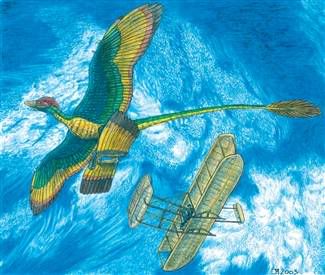
New analysis of the winged Microraptor gui suggests that the first feathered dinos relied on a biplane-like wing configuration to swoop from tree to tree. The result may settle a century-old controversy over how the first feathered creatures achieved flight.
"It is intriguing to contemplate that perhaps avian flight, like aircraft evolution, went through a biplane stage before the monoplane was introduced," said Sankar Chatterjee of Texas Tech University. "It seems likely that Microraptor invented the biplane 125 million years before the Wright 1903 Flyer.""

New analysis of the winged Microraptor gui suggests that the first feathered dinos relied on a biplane-like wing configuration to swoop from tree to tree. The result may settle a century-old controversy over how the first feathered creatures achieved flight.
"It is intriguing to contemplate that perhaps avian flight, like aircraft evolution, went through a biplane stage before the monoplane was introduced," said Sankar Chatterjee of Texas Tech University. "It seems likely that Microraptor invented the biplane 125 million years before the Wright 1903 Flyer.""
Friday, October 14, 2005
Chinese astronauts complete 3rd day in space
"Ships tracking China's Shenzhou 6 spacecraft encountered rough weather Friday and were preparing emergency measures in case conditions worsened, even as the astronauts completed their third day in orbit without a hitch, state media reported.
The four ships monitoring the spacecraft's position from posts in the Pacific, Indian and Atlantic oceans were fighting high winds and waves late Friday, the official Xinhua News Agency said.
Up in space, the capsule performed a delicate operation to adjust its orbit earlier in the day, and its two astronauts were well-rested and in good health, China Central Television said."
The four ships monitoring the spacecraft's position from posts in the Pacific, Indian and Atlantic oceans were fighting high winds and waves late Friday, the official Xinhua News Agency said.
Up in space, the capsule performed a delicate operation to adjust its orbit earlier in the day, and its two astronauts were well-rested and in good health, China Central Television said."
The king and I
"The World Chess Championship, San Luis, Argentina: what an event! The daily hecatombs of pieces and pawns have produced the most thrilling chess spectacle of recent decades. It is a pity there are so few visitors to the hall to witness the bloodbath. Never mind: the servers that carry the moves live around the globe are breaking all audience records.
One man, Bulgaria's Veselin Topalov, has given an exhibition of such virtuosity that it looks doubtful, at the halfway stage, that he can be stopped. The comparisons are not with Garry Kasparov - merely the greatest chess player ever - but with Bobby Fischer, the only modern giant capable of such thorough annihilation. Of course the 30-year-old could still falter: when the crown is within touching distance, strange things happen to all but the most steely-nerved."
One man, Bulgaria's Veselin Topalov, has given an exhibition of such virtuosity that it looks doubtful, at the halfway stage, that he can be stopped. The comparisons are not with Garry Kasparov - merely the greatest chess player ever - but with Bobby Fischer, the only modern giant capable of such thorough annihilation. Of course the 30-year-old could still falter: when the crown is within touching distance, strange things happen to all but the most steely-nerved."
Bobby Fischer Wants to Face Bulgaria's Topalov
"The legendary Bobby Fischer is willing to play against Bulgaria's chess master Vesselin Topalov, local Trud daily reported.
The newspaper cites an Australian reporter covering the World Chess Championship in San Luis. The reporter claims that Fischer is willing to face Topalov in a game of chess, but not the classical type of the game but a version invented by Fischer.
The Australian reporter has informed the manager of the Bulgarian chess master and says that he is preparing the game, Trud daily says."
The newspaper cites an Australian reporter covering the World Chess Championship in San Luis. The reporter claims that Fischer is willing to face Topalov in a game of chess, but not the classical type of the game but a version invented by Fischer.
The Australian reporter has informed the manager of the Bulgarian chess master and says that he is preparing the game, Trud daily says."
Thursday, October 13, 2005
Wednesday, October 12, 2005
Birdlike dinosaur may force raptor revisions
"The discovery of a birdlike dinosaur in South America has paleontologists rethinking when, where and how one group of raptors evolved.
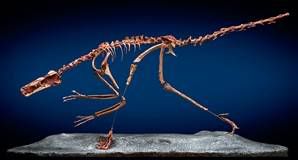
The rooster-sized dinosaur is called Buitreraptor (bwee-tree-rap-tor) gonzalezorum. It has a long head and long tail and winglike forelimbs. Its serrated teeth, shaped like steak knives, suggest it was a carnivore.
Buitreraptor is related to Velociraptor, the presumably cunning killer made famous by Hollywood. Both belong to a class of birdlike dinosaurs that ran swiftly on two legs and are called dromaeosaurs."

The rooster-sized dinosaur is called Buitreraptor (bwee-tree-rap-tor) gonzalezorum. It has a long head and long tail and winglike forelimbs. Its serrated teeth, shaped like steak knives, suggest it was a carnivore.
Buitreraptor is related to Velociraptor, the presumably cunning killer made famous by Hollywood. Both belong to a class of birdlike dinosaurs that ran swiftly on two legs and are called dromaeosaurs."
Labels:
birds
Tuesday, October 11, 2005
More bones of hobbit-sized humans discovered - Science - MSNBC.com
"Scientists digging in a remote Indonesian cave have uncovered a jawbone that they say adds more evidence that a tiny prehistoric Hobbit-like species once existed.
The jaw is from the ninth individual believed to have lived as recently as 12,000 years ago. The bones are in a wet cave on the island of Flores in the eastern limb of the Indonesian archipelago, near Australia.
The research team which reported the original sensational finding nearly a year ago strongly believes that the skeletons belong to a separate species of early human that shared Earth with modern humans far more recently than anyone thought."
The jaw is from the ninth individual believed to have lived as recently as 12,000 years ago. The bones are in a wet cave on the island of Flores in the eastern limb of the Indonesian archipelago, near Australia.
The research team which reported the original sensational finding nearly a year ago strongly believes that the skeletons belong to a separate species of early human that shared Earth with modern humans far more recently than anyone thought."
Labels:
floresiensis. flores,
hobbit
Thursday, October 06, 2005
The World's Smallest Fountain Pen
"Researchers have created the world's smallest fountain pen with a tip so tiny it can draw lines a hundred times thinner than a red blood cell.

Called the 'nanonfountain probe,' it can paint lines as thin as 40 nanometers and has its own reservoir to hold various types of inks, including pigments for painting patterns and organic materials for designing sensors.
Existing nano-pens use the same type of inks, but cannot hold an ink supply and must be dipped into the ink."

Called the 'nanonfountain probe,' it can paint lines as thin as 40 nanometers and has its own reservoir to hold various types of inks, including pigments for painting patterns and organic materials for designing sensors.
Existing nano-pens use the same type of inks, but cannot hold an ink supply and must be dipped into the ink."
Labels:
pens
Monday, October 03, 2005
'Planet Xena' has a sidekick -- Gabrielle
"The astronomers who claim to have discovered the 10th planet in the Earth's solar system have made another intriguing announcement: it has a moon.
The moon discovery is important because it can help scientists determine the new planet's mass. In July, Brown announced the discovery of an icy, rocky object larger than Pluto in the Kuiper Belt, a disc of icy bodies beyond Neptune. Brown labeled the object a planet and nicknamed it Xena after the lead character in the former TV series "Xena: Warrior Princess."
By determining the moon's distance and orbit around Xena, scientists can calculate how heavy Xena is. For example, the faster a moon goes around a planet, the more massive a planet is.
But the newly discovered moon, nicknamed Gabrielle after Xena's faithful traveling sidekick in the TV series, likely will not quell the debate over what exactly is a planet and whether Pluto should keep its status. The problem is there is no official definition for a planet and setting standards like size limits potentially invites other objects to take the "planet" label."
The moon discovery is important because it can help scientists determine the new planet's mass. In July, Brown announced the discovery of an icy, rocky object larger than Pluto in the Kuiper Belt, a disc of icy bodies beyond Neptune. Brown labeled the object a planet and nicknamed it Xena after the lead character in the former TV series "Xena: Warrior Princess."
By determining the moon's distance and orbit around Xena, scientists can calculate how heavy Xena is. For example, the faster a moon goes around a planet, the more massive a planet is.
But the newly discovered moon, nicknamed Gabrielle after Xena's faithful traveling sidekick in the TV series, likely will not quell the debate over what exactly is a planet and whether Pluto should keep its status. The problem is there is no official definition for a planet and setting standards like size limits potentially invites other objects to take the "planet" label."
Thursday, September 29, 2005
BBC NEWS | Liars 'possess more white matter'
... on the *other* hand....
"A University of Southern California team studied 49 people and found those known to be pathological liars had up to 26% more white matter than others.
White matter is the brain's thinking part - grey matter the wiring - and may provide the capacity to lie, it said. "
"A University of Southern California team studied 49 people and found those known to be pathological liars had up to 26% more white matter than others.
White matter is the brain's thinking part - grey matter the wiring - and may provide the capacity to lie, it said. "
Labels:
brain
Bigger Brains Make Smarter People
....on the other hand.....
"For more than a century some of the biggest minds in science have debated whether brain size has anything to do with intelligence. A new study suggests it does.
Bigger brains make for smarter people, says Michael McDaniel, an industrial and organizational psychologist at Virginia Commonwealth University.
'For all age and sex groups, it is now very clear that brain volume and intelligence are related,' McDaniel said."
"For more than a century some of the biggest minds in science have debated whether brain size has anything to do with intelligence. A new study suggests it does.
Bigger brains make for smarter people, says Michael McDaniel, an industrial and organizational psychologist at Virginia Commonwealth University.
'For all age and sex groups, it is now very clear that brain volume and intelligence are related,' McDaniel said."
Labels:
brain
Big Brains Not Always Better
"Nearly three million years ago, our ancestors had brains about as big as modern chimps. Since then the brain that would become human grew steadily, tripling in size. But this extra cranium capacity may not have resulted in smarter hominids.
As far as tool-making is concerned, there is little evidence of improvement over much of the period that the brain was growing.
'Archaeology has found that brain size grew gradually, but cleverness took steps,' said William Calvin, a neurobiologist from the University of Washington."
As far as tool-making is concerned, there is little evidence of improvement over much of the period that the brain was growing.
'Archaeology has found that brain size grew gradually, but cleverness took steps,' said William Calvin, a neurobiologist from the University of Washington."
Labels:
brain
Brain areas disconnect during deep sleep - LiveScience - MSNBC.com
"Your brain never stops working. But it does cease talking to itself when you lose consciousness, a new study shows.
Scientists have long wondered what the brain does and doesn't do during deep sleep. It remains active, they know. So what's the difference between consciousness and the lack of it?"
Scientists have long wondered what the brain does and doesn't do during deep sleep. It remains active, they know. So what's the difference between consciousness and the lack of it?"
Labels:
brain
Biologists Observe Gorillas Using Tools
"For the first time, biologists have documented gorillas in the wild using simple tools, such as poking a stick in a swampy pool of water to check its depth.
Until now, scientists had seen gorillas use tools only in captivity. Among the great apes, tool use in the wild was thought to be a survival skill reserved for smaller chimpanzees and orangutans.
The research in the Republic of Congo's rainforests was led by Thomas Breuer of the Wildlife Conservation Society at the Bronx Zoo, which released details of his study. Breuer is in Africa and was not immediately available for an interview.
'This is a truly astounding discovery,' he said in a statement. 'Tool usage in wild apes provides us with valuable insights into the evolution of our own species and the abilities of other species.'"
Until now, scientists had seen gorillas use tools only in captivity. Among the great apes, tool use in the wild was thought to be a survival skill reserved for smaller chimpanzees and orangutans.
The research in the Republic of Congo's rainforests was led by Thomas Breuer of the Wildlife Conservation Society at the Bronx Zoo, which released details of his study. Breuer is in Africa and was not immediately available for an interview.
'This is a truly astounding discovery,' he said in a statement. 'Tool usage in wild apes provides us with valuable insights into the evolution of our own species and the abilities of other species.'"
Labels:
ape,
gorilla,
intelligence
Can't Lie To An MRI
"A scientist at the Medical University of South Carolina has found that magnetic resonance imaging machines also can serve as lie detectors.
The study found MRI machines, which are used to take images of the brain, are more than 90 percent accurate at detecting deception, said Dr. Mark George, a distinguished professor of psychiatry, radiology and neurosciences.
That compares with polygraphs that range from 80 percent to 'no better than chance' at finding the truth, George said.
His results are to be published this week in the journal Biological Psychiatry. "
The study found MRI machines, which are used to take images of the brain, are more than 90 percent accurate at detecting deception, said Dr. Mark George, a distinguished professor of psychiatry, radiology and neurosciences.
That compares with polygraphs that range from 80 percent to 'no better than chance' at finding the truth, George said.
His results are to be published this week in the journal Biological Psychiatry. "
Scientists Capture Giant Squid in Photos
"The giant squid can be found in books and in myths, but for the first time, a team of Japanese scientists has captured on film one of the most mysterious creatures of the deep sea in its natural habitat.
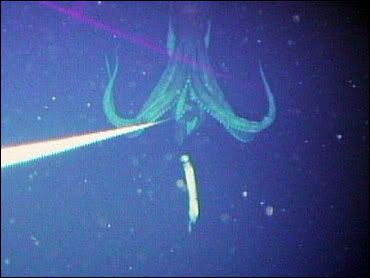
The team led by Tsunemi Kubodera, from the National Science Museum in Tokyo, tracked the 26-foot long Architeuthis as it attacked prey nearly 3,000 feet deep off the coast of Japan's Bonin islands.
'We believe this is the first time a grown giant squid has been captured on camera in its natural habitat,' said Kyoichi Mori, a marine researcher who co-authored a piece in Wednesday's issue of the Proceedings of the Royal Society B: Biological Sciences.
The camera was operated by remote control during research at the end of October 2004, Mori told The Associated Press on Wednesday."

The team led by Tsunemi Kubodera, from the National Science Museum in Tokyo, tracked the 26-foot long Architeuthis as it attacked prey nearly 3,000 feet deep off the coast of Japan's Bonin islands.
'We believe this is the first time a grown giant squid has been captured on camera in its natural habitat,' said Kyoichi Mori, a marine researcher who co-authored a piece in Wednesday's issue of the Proceedings of the Royal Society B: Biological Sciences.
The camera was operated by remote control during research at the end of October 2004, Mori told The Associated Press on Wednesday."
Labels:
squid
Dispelling a myth of dangerous Navy dolphins
'Countdown' investigates report of marine mammals armed and on the loose on the Gulf coast, and 'apparently' dispels earlier news reports. Click the link above to see a video on the subject.
Wednesday, September 28, 2005
Great optical illusion
If your eyes follow the movement of the rotating pink dot, you will only see one color, pink.

If you stare at the the black + in the center, the moving dot turns to green.
Now, concentrate on the black + in the center of the picture. After a short period of time, all the pink dots will slowly disappear, and you will only see a green dot rotating.
It's amazing how our brain works. There really is no green dot, and the pink ones really don't disappear. This should be proof enough, we don't always see what we think we see.

If you stare at the the black + in the center, the moving dot turns to green.
Now, concentrate on the black + in the center of the picture. After a short period of time, all the pink dots will slowly disappear, and you will only see a green dot rotating.
It's amazing how our brain works. There really is no green dot, and the pink ones really don't disappear. This should be proof enough, we don't always see what we think we see.
Monday, September 26, 2005
Armed and dangerous - Flipper the firing dolphin let loose by Katrina
"It may be the oddest tale to emerge from the aftermath of Hurricane Katrina. Armed dolphins, trained by the US military to shoot terrorists and pinpoint spies underwater, may be missing in the Gulf of Mexico.
Experts who have studied the US navy's cetacean training exercises claim the 36 mammals could be carrying 'toxic dart' guns. Divers and surfers risk attack, they claim, from a species considered to be among the planet's smartest. The US navy admits it has been training dolphins for military purposes, but has refused to confirm that any are missing.
Dolphins have been trained in attack-and-kill missions since the Cold War. The US Atlantic bottlenose dolphins have apparently been taught to shoot terrorists attacking military vessels. Their coastal compound was breached during the storm, sweeping them out to sea. But those who have studied the controversial use of dolphins in the US defence programme claim it is vital they are caught quickly.
Leo Sheridan, 72, a respected accident investigator who has worked for government and industry, said he had received intelligence from sources close to the US government's marine fisheries service confirming dolphins had escaped.
'My concern is that they have learnt to shoot at divers in wetsuits who have simulated terrorists in exercises. If divers or windsurfers are mistaken for a spy or suicide bomber and if equipped with special harnesses carrying toxic darts, they could fire,' he said. 'The darts are designed to put the target to sleep so they can be interrogated later, but what happens if the victim is not found for hours?'
Usually dolphins were controlled via signals transmitted through a neck harness. 'The question is, were these dolphins made secure before Katrina struck?' said Sheridan.
The mystery surfaced when a separate group of dolphins was washed from a commercial oceanarium on the Mississippi coast during Katrina. Eight were found with the navy's help, but the dolphins were not returned until US navy scientists had examined them.
Sheridan is convinced the scientists were keen to ensure the dolphins were not the navy's, understood to be kept in training ponds in a sound in Louisiana, close to Lake Pontchartrain, whose waters devastated New Orleans.
The navy launched the classified Cetacean Intelligence Mission in San Diego in 1989, where dolphins, fitted with harnesses and small electrodes planted under their skin, were taught to patrol and protect Trident submarines in harbour and stationary warships at sea.
Criticism from animal rights groups ensured the use of dolphins became more secretive. But the project gained impetus after the Yemen terror attack on the USS Cole in 2000. Dolphins have also been used to detect mines near an Iraqi port."
Experts who have studied the US navy's cetacean training exercises claim the 36 mammals could be carrying 'toxic dart' guns. Divers and surfers risk attack, they claim, from a species considered to be among the planet's smartest. The US navy admits it has been training dolphins for military purposes, but has refused to confirm that any are missing.
Dolphins have been trained in attack-and-kill missions since the Cold War. The US Atlantic bottlenose dolphins have apparently been taught to shoot terrorists attacking military vessels. Their coastal compound was breached during the storm, sweeping them out to sea. But those who have studied the controversial use of dolphins in the US defence programme claim it is vital they are caught quickly.
Leo Sheridan, 72, a respected accident investigator who has worked for government and industry, said he had received intelligence from sources close to the US government's marine fisheries service confirming dolphins had escaped.
'My concern is that they have learnt to shoot at divers in wetsuits who have simulated terrorists in exercises. If divers or windsurfers are mistaken for a spy or suicide bomber and if equipped with special harnesses carrying toxic darts, they could fire,' he said. 'The darts are designed to put the target to sleep so they can be interrogated later, but what happens if the victim is not found for hours?'
Usually dolphins were controlled via signals transmitted through a neck harness. 'The question is, were these dolphins made secure before Katrina struck?' said Sheridan.
The mystery surfaced when a separate group of dolphins was washed from a commercial oceanarium on the Mississippi coast during Katrina. Eight were found with the navy's help, but the dolphins were not returned until US navy scientists had examined them.
Sheridan is convinced the scientists were keen to ensure the dolphins were not the navy's, understood to be kept in training ponds in a sound in Louisiana, close to Lake Pontchartrain, whose waters devastated New Orleans.
The navy launched the classified Cetacean Intelligence Mission in San Diego in 1989, where dolphins, fitted with harnesses and small electrodes planted under their skin, were taught to patrol and protect Trident submarines in harbour and stationary warships at sea.
Criticism from animal rights groups ensured the use of dolphins became more secretive. But the project gained impetus after the Yemen terror attack on the USS Cole in 2000. Dolphins have also been used to detect mines near an Iraqi port."
RollingStone.com: Bob Dylan : Bob Dylan Looks Back
"Sitting through a three-and-a-half-hour documentary about an ex-boyfriend isn't most women's idea of fun. But Bob Dylan's early girlfriend Suze Rotolo says she enjoyed No Direction Home, the new Martin Scorsese-directed Dylan film that includes a rare on-camera interview with her. 'It was nice because the movie did not perpetuate that god myth,' says Rotolo, who inspired numerous Dylan songs and appears with him as a nineteen-year-old on the cover of 1963's The Freewheelin' Bob Dylan. 'It wasn't a fan talking about someone they mythologize -- it was coming from everybody's own story.'

The film, which airs tonight and tomorrow night on PBS and is also available on DVD, combines unearthed archival footage and fresh interviews -- with the likes of Joan Baez, Dave Van Ronk, Pete Seeger and Dylan himself -- to illuminate the first and most trailblazing part of Dylan's career, beginning with his Hibbing, Minnesota, childhood and ending with his 1966 Woodstock, New York, motorcycle accident. No Direction Home shows Dylan evolving at an unfathomable pace: In a span of just four years, he conquers the Greenwich Village folk scene, becomes the artistic voice of the civil-rights movement (Dylan is seen on the podium before Martin Luther King Jr.'s 'I have a dream' speech) and then abandons it all to reinvent rock & roll with 'Like a Rolling Stone' and everything that followed. 'It's an artist at the absolute peak of his talent,' says Nigel Sinclair, one of the producers. 'The challenge was making a film worthy of the subject.'"

The film, which airs tonight and tomorrow night on PBS and is also available on DVD, combines unearthed archival footage and fresh interviews -- with the likes of Joan Baez, Dave Van Ronk, Pete Seeger and Dylan himself -- to illuminate the first and most trailblazing part of Dylan's career, beginning with his Hibbing, Minnesota, childhood and ending with his 1966 Woodstock, New York, motorcycle accident. No Direction Home shows Dylan evolving at an unfathomable pace: In a span of just four years, he conquers the Greenwich Village folk scene, becomes the artistic voice of the civil-rights movement (Dylan is seen on the podium before Martin Luther King Jr.'s 'I have a dream' speech) and then abandons it all to reinvent rock & roll with 'Like a Rolling Stone' and everything that followed. 'It's an artist at the absolute peak of his talent,' says Nigel Sinclair, one of the producers. 'The challenge was making a film worthy of the subject.'"
Labels:
dylan
Sunday, September 25, 2005
Journal Gazette | Einstein, Bob Dylan, Sherlock Holmes among PBS fall programs
"Public broadcasting has again survived - for now - political attempts to cripple it with budgets cuts, which makes it either fitting or ironic that a long-planned centerpiece of PBS' fall season concerns those rollicking, politically contentious 1960s.
And in the middle of that is one of the highest-profile pieces PBS has aired in some time: Martin Scorsese's enthralling 3 1/2 -hour documentary on Bob Dylan called 'No Direction Home.'
The film, to be aired over two nights at 9 p.m. on Monday and Tuesday, focuses on the singer-songwriter's life from 1961 to 1966, the years of his rise as folk singer and cultural icon, and it is nothing short of fascinating - not just because Scorcese instills it with life and fills it with music, but because Dylan is a fascinating subject.
Scorsese tells the story with reams of archival footage (much of it contributed by the Dylan camp), through new and old interviews with people such as Joan Baez, Pete Seeger and Alan Ginsberg and through a series of fresh, and often candid interviews with Dylan, who does not seem comfortable with his status as the touchstone for a generation.
What emerges is a picture of a Dylan who is almost a savant, a genius at understanding the fundamentals of being human and at putting that to words and music, and of a Dylan who is contrarian by nature, always wanting to move forward, to achieve something different, to challenge himself and everyone."
And in the middle of that is one of the highest-profile pieces PBS has aired in some time: Martin Scorsese's enthralling 3 1/2 -hour documentary on Bob Dylan called 'No Direction Home.'
The film, to be aired over two nights at 9 p.m. on Monday and Tuesday, focuses on the singer-songwriter's life from 1961 to 1966, the years of his rise as folk singer and cultural icon, and it is nothing short of fascinating - not just because Scorcese instills it with life and fills it with music, but because Dylan is a fascinating subject.
Scorsese tells the story with reams of archival footage (much of it contributed by the Dylan camp), through new and old interviews with people such as Joan Baez, Pete Seeger and Alan Ginsberg and through a series of fresh, and often candid interviews with Dylan, who does not seem comfortable with his status as the touchstone for a generation.
What emerges is a picture of a Dylan who is almost a savant, a genius at understanding the fundamentals of being human and at putting that to words and music, and of a Dylan who is contrarian by nature, always wanting to move forward, to achieve something different, to challenge himself and everyone."
Labels:
dylan
Friday, September 23, 2005
BBC NEWS | Science/Nature | New 'Hobbit' disease link claim
"Scientists are to present new evidence that the tiny human species dubbed 'The Hobbit' may not be what it seems.
The researchers say their findings strongly support an idea that the 1m- (3ft-) tall female skeleton from Indonesia is a diseased modern human.

Their claims have been aired in a BBC Horizon programme screened on Thursday.
The Hobbit's discoverers are adamant it is an entirely separate human species, which evolved a small size in isolation on its remote island home of Flores.
The bones were unearthed during a dig at Liang Bua, a limestone cave deep in the Flores jungle. The discovery caused a sensation when it was announced to the world in 2004.

Analysis of the 18,000-year-old remains showed the Hobbit had reached adulthood, despite her diminutive size.
Long arms, a sloping chin, and other primitive features suggested affinities to ancient human species such as Homo erectus.
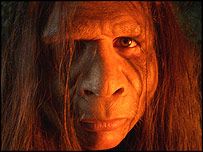
And Homo floresiensis, as science properly calls the creature, seems to exhibit other oddities, such as lower premolar teeth with twin roots. In most modern humans, the lower premolars have a single root.
Ancient roots
Australian anthropologists Peter Brown, Mike Morwood, Bert Roberts and others involved in the find, proposed that the Hobbit was a descendent of erectus or some other ancient species that reached Flores just under a million years ago.
Cut off from the rest of the world on this island, the species evolved small stature, much like the pygmy elephants it is thought to have hunted.
Sophisticated stone tools found nearby suggest they were not lacking in intelligence, even though the Hobbit specimen's brain was no larger than a chimpanzee's.
But it was not long before some scientists began to ask serious questions about the discovery team's conclusions.
Indonesian anthropologist Teuku Jacob controversially took possession of the remains and declared them to be those of a modern human with the condition microcephaly.
This disorder is characterised by a small brain, but it can also be associated with dwarfism, as well as abnormalities of the face and jaw. For this reason, some scientists believe the condition could cause a modern human to look primitive in evolutionary terms.
Jacob was soon joined by a handful of researchers in the belief that the discovery team had happened upon nothing more than a member of our own species with a rare disease.
Professor Bob Martin, one of the team that is set to publish new evidence challenging the discovery team's original interpretation, says the Hobbit's brain is "worryingly" small and contradicts a fundamental law of biology.
"What this law says in simple terms is that if you halve body size, brain size is only reduced by 15%," he told the BBC's Horizon programme.
"So if you halve body size you don't halve brain size, the brain is reduced far less than that."
Biological laws
Working under the assumption that the Hobbit was basically a shrunken form of Homo erectus, Professor Martin used this law to find out how big the Hobbit's brain should have been.
Starting with a height of 1.75m and a brain size of 990 cubic centimetres for Homo erectus, Professor Martin used the standard scaling formula to calculate that, given a height of 1m, the Hobbit's brain size should have been about 750 cubic centimetres.
"You can calculate what body height the Hobbit would need to get its brain down to this size, and the answer is... about the size of a meerkat," he said.
However, researchers who carried out the excavation at Liang Bua argue that island isolation can play strange evolutionary tricks.
"If they'd been isolated on this island for 800,000 years by themselves, genetically cut off from the rest of the world, where very few other animals could get to, we'd expect strange things," Mike Morwood of the University of New England, Australia, told Horizon.
But another piece of evidence challenging the discoverers' claims has come from one of the oldest anatomical collections in the world.
More remains
Ann MacLarnon of Roehampton University, UK, has discovered the skull of a microcephalic in the vaults of London's Royal College of Surgeons with a brain that matches that of the Hobbit for size.
"It showed that we really could demonstrate with a specimen that [microcephaly] could explain the Hobbit's small brain," she told Horizon.
But there's a problem with the sceptics' version of the story. The Hobbit team has found more human remains. These include a lower jaw with the same unusual features as the original find (including twin roots to the molars).
"Let's buy into [the sceptics'] argument just for a bit of fun," said Professor Bert Roberts of the University of Wollongong, Australia, a member of the discovery team.
"We've got a complete lower jaw that's identical to the first so there we have a situation where we've now got to have two really badly diseased individuals.
"We've got a diseased population like some sort of leper colony, living in Liang Bua 18,000 years ago. The probabilities have got to be vanishingly small."
The Hobbit team is now looking in other caves on Flores for more evidence of this ancient population.
The sceptics intend to publish their concerns in a scientific journal."
The researchers say their findings strongly support an idea that the 1m- (3ft-) tall female skeleton from Indonesia is a diseased modern human.

Their claims have been aired in a BBC Horizon programme screened on Thursday.
The Hobbit's discoverers are adamant it is an entirely separate human species, which evolved a small size in isolation on its remote island home of Flores.
The bones were unearthed during a dig at Liang Bua, a limestone cave deep in the Flores jungle. The discovery caused a sensation when it was announced to the world in 2004.

Analysis of the 18,000-year-old remains showed the Hobbit had reached adulthood, despite her diminutive size.
Long arms, a sloping chin, and other primitive features suggested affinities to ancient human species such as Homo erectus.

And Homo floresiensis, as science properly calls the creature, seems to exhibit other oddities, such as lower premolar teeth with twin roots. In most modern humans, the lower premolars have a single root.
Ancient roots
Australian anthropologists Peter Brown, Mike Morwood, Bert Roberts and others involved in the find, proposed that the Hobbit was a descendent of erectus or some other ancient species that reached Flores just under a million years ago.
Cut off from the rest of the world on this island, the species evolved small stature, much like the pygmy elephants it is thought to have hunted.
Sophisticated stone tools found nearby suggest they were not lacking in intelligence, even though the Hobbit specimen's brain was no larger than a chimpanzee's.
But it was not long before some scientists began to ask serious questions about the discovery team's conclusions.
Indonesian anthropologist Teuku Jacob controversially took possession of the remains and declared them to be those of a modern human with the condition microcephaly.
This disorder is characterised by a small brain, but it can also be associated with dwarfism, as well as abnormalities of the face and jaw. For this reason, some scientists believe the condition could cause a modern human to look primitive in evolutionary terms.
Jacob was soon joined by a handful of researchers in the belief that the discovery team had happened upon nothing more than a member of our own species with a rare disease.
Professor Bob Martin, one of the team that is set to publish new evidence challenging the discovery team's original interpretation, says the Hobbit's brain is "worryingly" small and contradicts a fundamental law of biology.
"What this law says in simple terms is that if you halve body size, brain size is only reduced by 15%," he told the BBC's Horizon programme.
"So if you halve body size you don't halve brain size, the brain is reduced far less than that."
Biological laws
Working under the assumption that the Hobbit was basically a shrunken form of Homo erectus, Professor Martin used this law to find out how big the Hobbit's brain should have been.
Starting with a height of 1.75m and a brain size of 990 cubic centimetres for Homo erectus, Professor Martin used the standard scaling formula to calculate that, given a height of 1m, the Hobbit's brain size should have been about 750 cubic centimetres.
"You can calculate what body height the Hobbit would need to get its brain down to this size, and the answer is... about the size of a meerkat," he said.
However, researchers who carried out the excavation at Liang Bua argue that island isolation can play strange evolutionary tricks.
"If they'd been isolated on this island for 800,000 years by themselves, genetically cut off from the rest of the world, where very few other animals could get to, we'd expect strange things," Mike Morwood of the University of New England, Australia, told Horizon.
But another piece of evidence challenging the discoverers' claims has come from one of the oldest anatomical collections in the world.
More remains
Ann MacLarnon of Roehampton University, UK, has discovered the skull of a microcephalic in the vaults of London's Royal College of Surgeons with a brain that matches that of the Hobbit for size.
"It showed that we really could demonstrate with a specimen that [microcephaly] could explain the Hobbit's small brain," she told Horizon.
But there's a problem with the sceptics' version of the story. The Hobbit team has found more human remains. These include a lower jaw with the same unusual features as the original find (including twin roots to the molars).
"Let's buy into [the sceptics'] argument just for a bit of fun," said Professor Bert Roberts of the University of Wollongong, Australia, a member of the discovery team.
"We've got a complete lower jaw that's identical to the first so there we have a situation where we've now got to have two really badly diseased individuals.
"We've got a diseased population like some sort of leper colony, living in Liang Bua 18,000 years ago. The probabilities have got to be vanishingly small."
The Hobbit team is now looking in other caves on Flores for more evidence of this ancient population.
The sceptics intend to publish their concerns in a scientific journal."
Labels:
floresiensis. flores,
hobbit
Thursday, September 22, 2005
Ananova - Artists erect giant pink bunny on mountain
"An enormous pink bunny has been erected on an Italian mountainside where it will stay for the next 20 years.
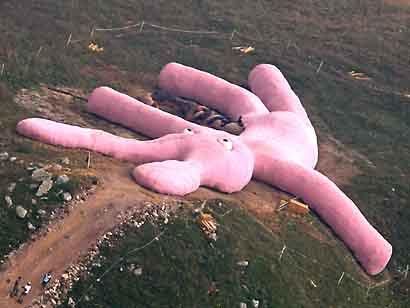
The 200-foot-long toy rabbit lies on the side of the 5,000 foot high Colletto Fava mountain in northern Italy's Piedmont region.
Viennese art group Gelatin designed the giant soft toy and say it was "knitted by dozens of grannies out of pink wool".
Group member Wolfgang Gantner said: "It's supposed to make you feel small, like Gulliver. You walk around it and you can't help but smile."
And Gelatin members say the bunny is not just for walking around - they are expecting hikers to climb its 20 foot sides and relax on its belly.
The giant rabbit is expected to remain on the mountain side until 2025."
"

The 200-foot-long toy rabbit lies on the side of the 5,000 foot high Colletto Fava mountain in northern Italy's Piedmont region.
Viennese art group Gelatin designed the giant soft toy and say it was "knitted by dozens of grannies out of pink wool".
Group member Wolfgang Gantner said: "It's supposed to make you feel small, like Gulliver. You walk around it and you can't help but smile."
And Gelatin members say the bunny is not just for walking around - they are expecting hikers to climb its 20 foot sides and relax on its belly.
The giant rabbit is expected to remain on the mountain side until 2025."
"
Wednesday, September 21, 2005
Displaced dolphins are rescued off Mississippi
Although I have real mixed feelings about the fact that these were, and are, captive dolphins, I do appreciate the fact that so many were concerned with their welfare and set about to do their best to rescue them...especially as three had been born in captivity, and most likely would not have fared well in the wild (as exemplified by their weight-loss).
Here's a link to my own experience swimming with a wild dolphin who had been truly rescued, due to injuries suffered in the wild.
"JACKSON, Miss. - The last of eight trained dolphins were rescued from the Mississippi Sound after spending weeks in the wild since Hurricane Katrina struck.
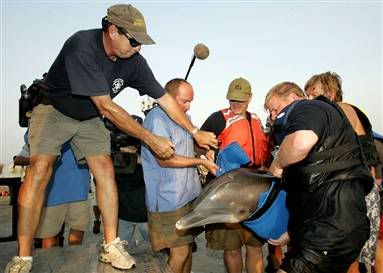
The dolphins who lived in captivity at the Marine Life Oceanarium in Gulfport were swept out to sea and scientists have been concerned about their safety ever since, said Connie Barclay, spokeswoman for the National Marine Fisheries Service. The four remaining dolphins were rescued Tuesday.
'I think it's been good news for a lot of people who have had a lot of bad news lately,' Barclay said. 'We have gotten calls and letters from all over the country.'
Before the hurricane hit the coast, the dolphins were moved to a pool at the Marine Life Oceanarium that had withstood the destruction of Hurricane Camille in 1969. Katrina destroyed that pool and pulled the mammals out to sea.
“Three of the dolphins were born at the facility, and had never been in the wild, compacting our concern for their well-being,” said Moby Solangi, owner and director for the Marine Life Aquarium."
Here's a link to my own experience swimming with a wild dolphin who had been truly rescued, due to injuries suffered in the wild.
"JACKSON, Miss. - The last of eight trained dolphins were rescued from the Mississippi Sound after spending weeks in the wild since Hurricane Katrina struck.

The dolphins who lived in captivity at the Marine Life Oceanarium in Gulfport were swept out to sea and scientists have been concerned about their safety ever since, said Connie Barclay, spokeswoman for the National Marine Fisheries Service. The four remaining dolphins were rescued Tuesday.
'I think it's been good news for a lot of people who have had a lot of bad news lately,' Barclay said. 'We have gotten calls and letters from all over the country.'
Before the hurricane hit the coast, the dolphins were moved to a pool at the Marine Life Oceanarium that had withstood the destruction of Hurricane Camille in 1969. Katrina destroyed that pool and pulled the mammals out to sea.
“Three of the dolphins were born at the facility, and had never been in the wild, compacting our concern for their well-being,” said Moby Solangi, owner and director for the Marine Life Aquarium."
Karpov ready to play against Fischer
"BUENOS AIRES, September 21 (RIA Novosti, Yury Nikolayev) - Multiple world chess champion Anatoly Karpov is ready to face Bobby Fischer, the Russian chess grandmaster told RIA Novosti Wednesday.
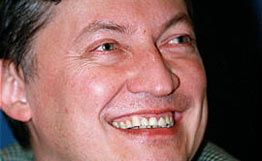
Karpov said the possibility of such a match depended solely on Fischer and getting sponsors. 'Fischer is hardly predictable. It depends on him, and of course, on the sponsors. Fischer is always interesting, but he wants to play his chess. That's no problem - we can play his chess.'
Karpov, who is currently the guest of honor at a chess festival in Argentina, said 'Fischer's chess' envisioned the initial position of the chess pieces defined by a computer. The pawns remain in their places, and a computer determines the other chess pieces' positions. "

Karpov said the possibility of such a match depended solely on Fischer and getting sponsors. 'Fischer is hardly predictable. It depends on him, and of course, on the sponsors. Fischer is always interesting, but he wants to play his chess. That's no problem - we can play his chess.'
Karpov, who is currently the guest of honor at a chess festival in Argentina, said 'Fischer's chess' envisioned the initial position of the chess pieces defined by a computer. The pawns remain in their places, and a computer determines the other chess pieces' positions. "
Tuesday, September 20, 2005
Rover Tracks Seen from Orbit

"Wheel tracks left by NASA's Mars Exploration Rover Spirit, and even the rover itself, are visible in this image from the Mars Orbiter Camera on NASA's Mars Global Surveyor orbiter. North is up in this image. The tracks and rover are in the area south of a crater informally named 'Bonneville,' which is just southeast of the center of the image. The orbiter captured this image with use of an enhanced-resolution technique called compensated pitch and roll targeted observation. It took the picture on March 30, 2004, 85 martian days, or sols, after Spirit landed on Mars. The rover had driven from its landing site to the rim of Bonneville and was examining materials around the crater's rim. "
Labels:
mars
NASA estimates $104 billion for return to moon
"Despite a stalled space shuttle program, NASA is confident it can launch and sustain human exploration of the moon by 2018, the space agency's top official said Monday.

The $104 billion plan calls for an Apollo-like vehicle to carry crews of up to four astronauts to the moon for seven-day stays on the lunar surface. The spacecraft, known as the Crew Exploration Vehicle or CEV, could even carry six-astronaut crews to the international space station or fly automated resupply shipments as needed, NASA Administrator Michael Griffin said.
'Think of it as Apollo on steroids,' Griffin said as he unveiled the agency's lunar exploration plan during a much-anticipated press conference at its Washington headquarters. 'Unless the U.S. wants to get out of manned spaceflight completely, this is the vehicle we need to be building.'"

The $104 billion plan calls for an Apollo-like vehicle to carry crews of up to four astronauts to the moon for seven-day stays on the lunar surface. The spacecraft, known as the Crew Exploration Vehicle or CEV, could even carry six-astronaut crews to the international space station or fly automated resupply shipments as needed, NASA Administrator Michael Griffin said.
'Think of it as Apollo on steroids,' Griffin said as he unveiled the agency's lunar exploration plan during a much-anticipated press conference at its Washington headquarters. 'Unless the U.S. wants to get out of manned spaceflight completely, this is the vehicle we need to be building.'"
Friday, September 16, 2005
Two dolphins retrieved in Gulf, six to go
"JACKSON, Miss. - Two anemic dolphins that were swept from their aquarium tanks into the Gulf of Mexico by Hurricane Katrina were retrieved Thursday, but six others remained at sea.

Steve Helber / AP
Specialists on Thursday work with and feed several of the bottlenosed dolphins they hope to retrieve. Earlier in the day, two dolphins were retrieved and taken to a swimming pool.
The two retrieved dolphins were captured after scientists in a boat coaxed the trained animals into sliding onto mats.
The dolphins had cuts and appeared to be the worst injured of the eight, Jeff Foster, a marine specialist with the National Oceanic and Atmospheric Administration. They were immediately moved to a hotel swimming pool."

Steve Helber / AP
Specialists on Thursday work with and feed several of the bottlenosed dolphins they hope to retrieve. Earlier in the day, two dolphins were retrieved and taken to a swimming pool.
The two retrieved dolphins were captured after scientists in a boat coaxed the trained animals into sliding onto mats.
The dolphins had cuts and appeared to be the worst injured of the eight, Jeff Foster, a marine specialist with the National Oceanic and Atmospheric Administration. They were immediately moved to a hotel swimming pool."
Thursday, September 15, 2005
Pen production halts by May
"FORT MADISON --- After pausing to honor the grandson of the historic pen factory's founder, workers at the Sheaffer plant here were told to expect a complete plant closure by May.
Linda Kwong of Bic Corp., Sheaffer's Paris-based parent company, said production at the plant will be transferred to third-party manufacturing plants in Europe and Asia, a transition that will begin in the fourth quarter.
The pen point assembly department will be transferred to Bic's fountain pen facility in South Carolina, and nib making will be sourced to an outside European vendor, she said.
Molding will wind down by the end of the month, she added.
Bic announced it would be closing the Fort Madison landmark in March 2004, closing the plant two years shy of its 100th anniversary.
Sheaffer pens were a groundbreaking invention, with the lever-filling pen patented by Walter Sheaffer in 1908.
The company was family-owned until it was sold in 1966 to Textron. In 1976, Textron merged Sheaffer with Eaton Paper Co. in 1976 and, 11 years later, sold Sheaffer-Eaton to Genifor, which returned the plant to the original name of Sheaffer Pen Co.
Over the past century, the fountain pens have become an iconic Iowa product, with governors traditionally signing state bills into law with Sheaffers.
Between five and 10 of the company's 120 employees will be laid off by the end of 2005, although Kwong said that number may change due to the seasonality of Sheaffer's business.
'That's our guess-timate,' she added.
The majority of the layoffs will come in waves during the first quarter of 2006, she said.
'All work force reductions will be made according to the unions' collective bargaining agreement," Kwong said. "This means that displaced union employees with seniority will be able to 'bump' into the remaining jobs as depart–ments/functions are shut down."
Production workers at the plant are represented by United Auto Workers Local 1551.
Bic officially put the 301 Avenue H plant, located at the north end of Fort Madison's downtown, on the market last week.
Kwong said administrative functions like customer service, finance and purchasing will be transferred to Bic facilities in Milford, Conn., and Charlotte, N.C., with more details on those transitions expected in the next few months.
Final assembly, packaging, warehousing and distribution also will be relocated to Charlotte.
"During the meeting, Sheaffer management thanked employees for their continued support and patience throughout this difficult transition process and said they would provide further updates as plans were finalized," Kwong added.
She noted that workers at the Sheaffer plant observed a moment of silence to mark the passing of Walter A. Sheaffer II, the grandson of the company's founder.
The younger Sheaffer was named chairman of the board and chief executive officer of the company in 1960. He also served as president of company divisions Sheaffer Western Hemisphere and Sheaffer International.
The U.S. Army veteran, who died at age 83, served in World War II. He also was a former trustee at Iowa Wesleyan College, a member of the Iowa College Foundation board of governors and, at the time of his death, was serving as president of the board of trustees of the W.A. Sheaffer Memorial Foundation."
Linda Kwong of Bic Corp., Sheaffer's Paris-based parent company, said production at the plant will be transferred to third-party manufacturing plants in Europe and Asia, a transition that will begin in the fourth quarter.
The pen point assembly department will be transferred to Bic's fountain pen facility in South Carolina, and nib making will be sourced to an outside European vendor, she said.
Molding will wind down by the end of the month, she added.
Bic announced it would be closing the Fort Madison landmark in March 2004, closing the plant two years shy of its 100th anniversary.
Sheaffer pens were a groundbreaking invention, with the lever-filling pen patented by Walter Sheaffer in 1908.
The company was family-owned until it was sold in 1966 to Textron. In 1976, Textron merged Sheaffer with Eaton Paper Co. in 1976 and, 11 years later, sold Sheaffer-Eaton to Genifor, which returned the plant to the original name of Sheaffer Pen Co.
Over the past century, the fountain pens have become an iconic Iowa product, with governors traditionally signing state bills into law with Sheaffers.
Between five and 10 of the company's 120 employees will be laid off by the end of 2005, although Kwong said that number may change due to the seasonality of Sheaffer's business.
'That's our guess-timate,' she added.
The majority of the layoffs will come in waves during the first quarter of 2006, she said.
'All work force reductions will be made according to the unions' collective bargaining agreement," Kwong said. "This means that displaced union employees with seniority will be able to 'bump' into the remaining jobs as depart–ments/functions are shut down."
Production workers at the plant are represented by United Auto Workers Local 1551.
Bic officially put the 301 Avenue H plant, located at the north end of Fort Madison's downtown, on the market last week.
Kwong said administrative functions like customer service, finance and purchasing will be transferred to Bic facilities in Milford, Conn., and Charlotte, N.C., with more details on those transitions expected in the next few months.
Final assembly, packaging, warehousing and distribution also will be relocated to Charlotte.
"During the meeting, Sheaffer management thanked employees for their continued support and patience throughout this difficult transition process and said they would provide further updates as plans were finalized," Kwong added.
She noted that workers at the Sheaffer plant observed a moment of silence to mark the passing of Walter A. Sheaffer II, the grandson of the company's founder.
The younger Sheaffer was named chairman of the board and chief executive officer of the company in 1960. He also served as president of company divisions Sheaffer Western Hemisphere and Sheaffer International.
The U.S. Army veteran, who died at age 83, served in World War II. He also was a former trustee at Iowa Wesleyan College, a member of the Iowa College Foundation board of governors and, at the time of his death, was serving as president of the board of trustees of the W.A. Sheaffer Memorial Foundation."
Wednesday, September 14, 2005
Is Octopus Ink Similar to Fountain Pen Ink?
"By Nancy King
What Is Octopus Ink?
The ink of the octopus, or any cephalopod, is composed of highly concentrated melanin. This is the same dark pigment that we humans have, and which is responsible for skin color and the color of dark hair. It is a natural dye that cephalopods manufacture in an ink sac. Most, but not all octopuses have an ink sac and produce ink, but a few, such as the deep-sea octopuses, have lost this ability.
When the need arises, octopuses squirt this ink together with a jet of water and are able to guide the direction of the squirt. The result is a cloud of ink, which is used defensively as a visual screen or a distraction to predators. The ink also contains a compound, tyrosinase, which irritates predators' eyes and paralyzes their sense of smell temporarily.
The color of the ink (melanin) is red, but when it is more concentrated, it becomes darker, changing to brown and even to black. Since red appears black in low-light, many night active or deep-sea cephalopods produce only red or brown ink.
An interesting discussion of octopus ink and the ink of other cephalopods can be found in Cephalopods, a World Guide.
What is Fountain Pen Ink?
The ink that we use in fountain pens or ball-point pens today bears little resemblance to octopus ink. In it's simplest form, the ink we write with is a pigment or dye and a binder. The first ink for writing and drawing was invented simultaneously in China and Egypt, around 2500 BC. This first ink was made of lampblack (soot) mixed with aqueous binders. In the middle ages and up through the nineteenth century, ink was made from such ingredients as gum arabic, copperas (vitriol), gall apples (source of tannin), and water. Occasionally soot was used for making the ink black, or minerals and other pigments could be used for color. In this century, ink has become more sophisticated and is now usually made of synthetic dyes and compounds. Ink today may combine tannic, Gallic and dilute hydrochloric acid with an iron salt, phenol, and a blue or black dye. The composition may optionally include a drying agent, an adhesion promoter, a color developer and/or a preservative. Some inks are made thicker, such as printing ink.
Sepia Ink
There is one ink that is related to cephalopods: the historical artists' ink sepia, one of the brown inks used by artists for their pen and ink drawings. Sepia is a red-brown ink made from the ink sacs of cuttlefish, which are dried and ground to a fine powder, then mixed with shellac. (The ink takes is name from the cuttlefish species Sepia officinalis.) This ink came into use in the eighteenth century and was quite popular in the nineteenth century. It is sometimes difficult to identify a true sepia ink drawing, since other brown inks were in use as well. True sepia ink is still available from specialized artists' supply houses on the Internet. The term sepia now also applies to any red-brown color similar to the color of sepia ink."
What Is Octopus Ink?
The ink of the octopus, or any cephalopod, is composed of highly concentrated melanin. This is the same dark pigment that we humans have, and which is responsible for skin color and the color of dark hair. It is a natural dye that cephalopods manufacture in an ink sac. Most, but not all octopuses have an ink sac and produce ink, but a few, such as the deep-sea octopuses, have lost this ability.
When the need arises, octopuses squirt this ink together with a jet of water and are able to guide the direction of the squirt. The result is a cloud of ink, which is used defensively as a visual screen or a distraction to predators. The ink also contains a compound, tyrosinase, which irritates predators' eyes and paralyzes their sense of smell temporarily.
The color of the ink (melanin) is red, but when it is more concentrated, it becomes darker, changing to brown and even to black. Since red appears black in low-light, many night active or deep-sea cephalopods produce only red or brown ink.
An interesting discussion of octopus ink and the ink of other cephalopods can be found in Cephalopods, a World Guide.
What is Fountain Pen Ink?
The ink that we use in fountain pens or ball-point pens today bears little resemblance to octopus ink. In it's simplest form, the ink we write with is a pigment or dye and a binder. The first ink for writing and drawing was invented simultaneously in China and Egypt, around 2500 BC. This first ink was made of lampblack (soot) mixed with aqueous binders. In the middle ages and up through the nineteenth century, ink was made from such ingredients as gum arabic, copperas (vitriol), gall apples (source of tannin), and water. Occasionally soot was used for making the ink black, or minerals and other pigments could be used for color. In this century, ink has become more sophisticated and is now usually made of synthetic dyes and compounds. Ink today may combine tannic, Gallic and dilute hydrochloric acid with an iron salt, phenol, and a blue or black dye. The composition may optionally include a drying agent, an adhesion promoter, a color developer and/or a preservative. Some inks are made thicker, such as printing ink.
Sepia Ink
There is one ink that is related to cephalopods: the historical artists' ink sepia, one of the brown inks used by artists for their pen and ink drawings. Sepia is a red-brown ink made from the ink sacs of cuttlefish, which are dried and ground to a fine powder, then mixed with shellac. (The ink takes is name from the cuttlefish species Sepia officinalis.) This ink came into use in the eighteenth century and was quite popular in the nineteenth century. It is sometimes difficult to identify a true sepia ink drawing, since other brown inks were in use as well. True sepia ink is still available from specialized artists' supply houses on the Internet. The term sepia now also applies to any red-brown color similar to the color of sepia ink."
Sunday, September 11, 2005
Bringing it all back
One of the best 'reviews' of Dylan's career that I've read.
"NIGEL WILLIAMSON
AS NATURE turns to reveal its autumnal hues, and the chill in the wind forces shoulders to hunch themselves against the elements, we find ourselves in what can only be described as Bob Dylan season, a momentously high-profile flurry of activity that finds rock'n'roll's most enigmatic songwriter on an unprecedented mission to explain himself to us.

This month his publishers are putting out The Bob Dylan Scrapbook 1956-66, based on his personal archive and including a reproduction from his high school yearbook, facsimiles of handwritten lyrics and even his platform pass from when he sat a few feet away from Martin Luther King as he made his 'I have a dream' speech in Washington in 1963. Not only that, but a three-week season of films honouring Dylan is under way at the National Film Theatre in London, and next week a month-long exhibition of rare photographs opens at London's Proud Gallery. The man himself embarks on a new British tour in November.
All that's needed to crown the celebration is the Nobel Prize for Literature - and don't rule that out. This year's winner is due to be announced in October, and the bookmaker's have him down among the favourites to be the recipient.
Last year, Dylan published Chronicles Volume 1, the first instalment of the autobiography he had promised he would never write. On Tuesday, it will be reissued on paperback. To promote the book, he gave his first television interview in 20 years. Now comes No Direction Home, a two-part, four-hour documentary about his early life, made by Martin Scorsese with Dylan's full co-operation. It is accompanied by a double CD of rarities from his vaults, including his earliest and never previously heard recording, made in 1959 when he was still in school.
Dylan's songs may be famous for their searing honesty, but the man has been telling lies about himself all his life. You can call it self-mythologising or protecting his privacy, if you like. But throughout his long career, Dylan has deliberately laid a trail of half-truth, obfuscation and pure fiction that has fostered a highly marketable sense of mystery and intrigue around the man and his body of work.
At various times he has told us that he ran away from school to join a carnival, was descended from Sioux Indians, was an orphan and had been a hobo. In fact, at the time of all these stories, he had been growing up quietly with his Jewish parents in a small mining town in Minnesota. He lied about his name, denying that it was taken from Dylan Thomas but came from his mother, when her family name was actually Stone.
The deceptions continued into his later career. Some were major untruths, others simply mischievous inexactitudes. When he released a retrospective of his recorded work in the early 1990s, he included a photo of his driving licence in the liner notes but impishly altered his date of birth, turning himself with the stroke of a forger's pen from a Gemini to a Taurus. Perhaps he just did it to confuse the professional Dylan nutters who read his stars in an attempt to discern the secrets of his life.
For most of his career, his rare interviews have been exercises in verbal jousting, characterised by vague and often surreal answers. If that failed to throw them off his scent, he'd resort to mumbling. When asked what his songs were about, he once answered: "Some are about four minutes. Some are about five. And some, believe or not, are about 11 or 12.''
Then there was his preposterous claim that Blood On The Tracks, one of his greatest albums and a raw and emotional collection of songs about his divorce from his first wife, was not autobiographical at all but based on a collection of short stories by Chekhov. Right, Bob. Pull the other one.
"These so-called connoisseurs of Bob Dylan music, I don't feel they know a thing or have any inkling of who I am or what I am about,'' he declared four years ago on the occasion of his 60th birthday. And he made it clear that he intended to keep it that way, adding, "My life is private and personal and completely filled up." Churchill said of Stalin's Russia that it was a riddle wrapped in a mystery inside an enigma. Dylan has spent years happily adding several more layers of conundrum and confusion to the equation.
Yet it is clear that something has dramatically changed. He hasn't made a new record since 2001's Love And Theft. So why has Dylan - a man so secretive that the world didn't even know he had married again in the 1980s until more than a decade later, by which time he was once more divorced - decided finally to set the record straight?
First, it would not be unreasonable to question to what extent he really is coming clean. Given his track record, are the book and the film not further episodes in his endless self-mythologising?
Perhaps. But we do genuinely learn much about Dylan and his art from No Direction Home. If the story is familiar, never before have we felt ourselves inside it, as we do here. Via an extended interview that runs in snippets throughout the film, Scorsese in effect uses Dylan as the narrator of his own life story - and he's not only a uniquely insightful observer but a surprisingly candid one, too. On the subject of his many lies, he admits that as a young man he felt like someone who didn't have a past - so he made one up. There's a similar honesty to the interviews with those who know him in the 1950s and 1960s, from old Minnesota friends (including one who accuses Dylan of stealing his record collection) to early lovers such as Suze Rotolo and Joan Baez.
The previously unseen footage is equally revelatory. Scorsese ends the film in the summer of 1966, with Dylan at the conclusion of his monumental, drug-fuelled world tour during which audiences booed his electric set and, on one infamous occasion, shouted "Judas!" at him. Haggard, frayed and cadaverously pale with his eyes sunk somewhere deep in the back of his skull, in the final scene he looks like someone who is about to die. Incapable of rational speech, he whines: "I just wanna go home."
When he got back to Woodstock shortly afterwards, he had the motorcycle crash that enabled him to get off the merry-go-round that was killing him. In retrospect, we can see that the crash probably saved his life.
So why did Dylan allow the film to be made? Presumably, for the same reason he wrote Chronicles and has sanctioned the publication of Scrapbook. Now in his sixties, he has come to reflect upon his place in history and, like many struck by the realisation that a time is coming when they're no longer going to be around, felt the need to get his version of his life and times on the record for posterity - and to do so on his own terms. For the brilliance of the film, like Chronicles, is that although we get an endlessly fascinating portrait of Dylan in which so much is revealed, at the same time the mystery, essential to an appreciation of any great art, is retained.
Should Dylan now cap his long career by lifting the Nobel Prize for literature, surely few could begrudge him the honour. Born Robert Zimmerman in Hibbing, Minnesota, in May 1941, like Shakespeare growing up in the dull Elizabethan backwater of Stratford-upon-Avon, there was nothing in his background or upbringing to suggest the mark he would go on to leave on the world. In No Direction Home, he describes his life-long journey as a songwriter and musician as "trying to get home". The phrase helped to inspire the film's title (lifted from the lyrics of 'Like A Rolling Stone') and what Dylan thinks of as home is a subject for endless speculation. Yet for all the ups-and-downs and inconsistencies of his career, there has been an underlying integrity that can be seen as constituting an uninterrupted search and a continuing odyssey.
When he arrived as a would-be folk singer in New York in early 1961, he unashamedly copied Woody Guthrie while he sought his own voice. Yet one of the most fascinating aspects of No Direction Home is its depiction of how swiftly he found that voice and how fast Dylan was travelling in the 1960s. Within a year he was the one being copied. He was a product of his times, shaped and moulded by the civil rights struggle and cold war fears of nuclear holocaust.
But he then articulated those times via some of the most potent and coruscating protest songs ever written that made him - in a phrase he hated - the voice of his generation. Some of them were written with the precision of news reports. Others, such as 'Blowin' In The Wind', 'The Times They Are A-Changin', 'Masters Of War' and 'A Hard Rain's A-Gonna Fall', had a universal quality that made them anthems not just of their time but for all time.
Within a couple of years he had left protest behind for the broader poetic vision of songs such as 'Mr Tambourine Man', influencing the Beatles among others to begin writing lyrics more meaningful than the Tin Pan Alley banalities of 'She Loves You'.
When Dylan himself decided to make the transition from folk hero to electric messiah, he found himself at the centre of a storm of protest. Yet by marrying lyrics that name-checked Ezra Pound and TS Eliot as well as Ma Rainey and Beethoven to a rock'n'roll backbeat, he revolutionised popular music.
In just 16 months between 1965-66, he released arguably the greatest trilogy of rock albums ever made, in Bringing It All Back Home, Highway 61 Revisited and Blonde On Blonde. They included such classic songs as 'Subterranean Homesick Blues', 'It's All Over Now Baby Blue', 'Desolation Row', 'Ballad Of A Thin Man', 'Visions Of Johanna' and 'Like A Rolling Stone'.
Then came the inevitable burn-out. He retired from the road for eight years, released a country album and then a deliberately terrible record (Self Portrait) in an effort to shed his image as the leader of the counter-culture. There followed a born-again period, a mid-life crisis in the 1980s in which he lost the plot and then his reinvention via the Never Ending Tour, in the course of which he has played some 1,700 shows since 1989, averaging more than 100 per year - even in 1997 when he was hospitalised with a potentially fatal disease and quipped that he thought he was going to meet Elvis. That same year he released one of the best albums of his career in Time Out Of Mind, the most profound response to mortality and the ageing process that rock music has yet mustered.
His influence on modern culture remains all-pervasive. When asked how he had been influenced by Dylan, Pete Townshend replied that it was like asking how he had been affected by being born. Dylan's songs changed the world and there is not a songwriter on the planet who has not been influenced by him. Even those who may claim they've never listened to a Dylan record will find they were inspired or affected by others who fell under his dancing spell.
And although the story may be approaching its concluding chapters, it is still far from over. The Beatles played their last concert in 1966 and Elvis is long gone. The Rolling Stones are touring again, but are essentially a nostalgia act, coasting on past glories. Dylan is still up there doing it night after night on his 'never ending tour', reinventing the songs that changed the world and minting them anew before our very eyes."
"NIGEL WILLIAMSON
AS NATURE turns to reveal its autumnal hues, and the chill in the wind forces shoulders to hunch themselves against the elements, we find ourselves in what can only be described as Bob Dylan season, a momentously high-profile flurry of activity that finds rock'n'roll's most enigmatic songwriter on an unprecedented mission to explain himself to us.

This month his publishers are putting out The Bob Dylan Scrapbook 1956-66, based on his personal archive and including a reproduction from his high school yearbook, facsimiles of handwritten lyrics and even his platform pass from when he sat a few feet away from Martin Luther King as he made his 'I have a dream' speech in Washington in 1963. Not only that, but a three-week season of films honouring Dylan is under way at the National Film Theatre in London, and next week a month-long exhibition of rare photographs opens at London's Proud Gallery. The man himself embarks on a new British tour in November.
All that's needed to crown the celebration is the Nobel Prize for Literature - and don't rule that out. This year's winner is due to be announced in October, and the bookmaker's have him down among the favourites to be the recipient.
Last year, Dylan published Chronicles Volume 1, the first instalment of the autobiography he had promised he would never write. On Tuesday, it will be reissued on paperback. To promote the book, he gave his first television interview in 20 years. Now comes No Direction Home, a two-part, four-hour documentary about his early life, made by Martin Scorsese with Dylan's full co-operation. It is accompanied by a double CD of rarities from his vaults, including his earliest and never previously heard recording, made in 1959 when he was still in school.
Dylan's songs may be famous for their searing honesty, but the man has been telling lies about himself all his life. You can call it self-mythologising or protecting his privacy, if you like. But throughout his long career, Dylan has deliberately laid a trail of half-truth, obfuscation and pure fiction that has fostered a highly marketable sense of mystery and intrigue around the man and his body of work.
At various times he has told us that he ran away from school to join a carnival, was descended from Sioux Indians, was an orphan and had been a hobo. In fact, at the time of all these stories, he had been growing up quietly with his Jewish parents in a small mining town in Minnesota. He lied about his name, denying that it was taken from Dylan Thomas but came from his mother, when her family name was actually Stone.
The deceptions continued into his later career. Some were major untruths, others simply mischievous inexactitudes. When he released a retrospective of his recorded work in the early 1990s, he included a photo of his driving licence in the liner notes but impishly altered his date of birth, turning himself with the stroke of a forger's pen from a Gemini to a Taurus. Perhaps he just did it to confuse the professional Dylan nutters who read his stars in an attempt to discern the secrets of his life.
For most of his career, his rare interviews have been exercises in verbal jousting, characterised by vague and often surreal answers. If that failed to throw them off his scent, he'd resort to mumbling. When asked what his songs were about, he once answered: "Some are about four minutes. Some are about five. And some, believe or not, are about 11 or 12.''
Then there was his preposterous claim that Blood On The Tracks, one of his greatest albums and a raw and emotional collection of songs about his divorce from his first wife, was not autobiographical at all but based on a collection of short stories by Chekhov. Right, Bob. Pull the other one.
"These so-called connoisseurs of Bob Dylan music, I don't feel they know a thing or have any inkling of who I am or what I am about,'' he declared four years ago on the occasion of his 60th birthday. And he made it clear that he intended to keep it that way, adding, "My life is private and personal and completely filled up." Churchill said of Stalin's Russia that it was a riddle wrapped in a mystery inside an enigma. Dylan has spent years happily adding several more layers of conundrum and confusion to the equation.
Yet it is clear that something has dramatically changed. He hasn't made a new record since 2001's Love And Theft. So why has Dylan - a man so secretive that the world didn't even know he had married again in the 1980s until more than a decade later, by which time he was once more divorced - decided finally to set the record straight?
First, it would not be unreasonable to question to what extent he really is coming clean. Given his track record, are the book and the film not further episodes in his endless self-mythologising?
Perhaps. But we do genuinely learn much about Dylan and his art from No Direction Home. If the story is familiar, never before have we felt ourselves inside it, as we do here. Via an extended interview that runs in snippets throughout the film, Scorsese in effect uses Dylan as the narrator of his own life story - and he's not only a uniquely insightful observer but a surprisingly candid one, too. On the subject of his many lies, he admits that as a young man he felt like someone who didn't have a past - so he made one up. There's a similar honesty to the interviews with those who know him in the 1950s and 1960s, from old Minnesota friends (including one who accuses Dylan of stealing his record collection) to early lovers such as Suze Rotolo and Joan Baez.
The previously unseen footage is equally revelatory. Scorsese ends the film in the summer of 1966, with Dylan at the conclusion of his monumental, drug-fuelled world tour during which audiences booed his electric set and, on one infamous occasion, shouted "Judas!" at him. Haggard, frayed and cadaverously pale with his eyes sunk somewhere deep in the back of his skull, in the final scene he looks like someone who is about to die. Incapable of rational speech, he whines: "I just wanna go home."
When he got back to Woodstock shortly afterwards, he had the motorcycle crash that enabled him to get off the merry-go-round that was killing him. In retrospect, we can see that the crash probably saved his life.
So why did Dylan allow the film to be made? Presumably, for the same reason he wrote Chronicles and has sanctioned the publication of Scrapbook. Now in his sixties, he has come to reflect upon his place in history and, like many struck by the realisation that a time is coming when they're no longer going to be around, felt the need to get his version of his life and times on the record for posterity - and to do so on his own terms. For the brilliance of the film, like Chronicles, is that although we get an endlessly fascinating portrait of Dylan in which so much is revealed, at the same time the mystery, essential to an appreciation of any great art, is retained.
Should Dylan now cap his long career by lifting the Nobel Prize for literature, surely few could begrudge him the honour. Born Robert Zimmerman in Hibbing, Minnesota, in May 1941, like Shakespeare growing up in the dull Elizabethan backwater of Stratford-upon-Avon, there was nothing in his background or upbringing to suggest the mark he would go on to leave on the world. In No Direction Home, he describes his life-long journey as a songwriter and musician as "trying to get home". The phrase helped to inspire the film's title (lifted from the lyrics of 'Like A Rolling Stone') and what Dylan thinks of as home is a subject for endless speculation. Yet for all the ups-and-downs and inconsistencies of his career, there has been an underlying integrity that can be seen as constituting an uninterrupted search and a continuing odyssey.
When he arrived as a would-be folk singer in New York in early 1961, he unashamedly copied Woody Guthrie while he sought his own voice. Yet one of the most fascinating aspects of No Direction Home is its depiction of how swiftly he found that voice and how fast Dylan was travelling in the 1960s. Within a year he was the one being copied. He was a product of his times, shaped and moulded by the civil rights struggle and cold war fears of nuclear holocaust.
But he then articulated those times via some of the most potent and coruscating protest songs ever written that made him - in a phrase he hated - the voice of his generation. Some of them were written with the precision of news reports. Others, such as 'Blowin' In The Wind', 'The Times They Are A-Changin', 'Masters Of War' and 'A Hard Rain's A-Gonna Fall', had a universal quality that made them anthems not just of their time but for all time.
Within a couple of years he had left protest behind for the broader poetic vision of songs such as 'Mr Tambourine Man', influencing the Beatles among others to begin writing lyrics more meaningful than the Tin Pan Alley banalities of 'She Loves You'.
When Dylan himself decided to make the transition from folk hero to electric messiah, he found himself at the centre of a storm of protest. Yet by marrying lyrics that name-checked Ezra Pound and TS Eliot as well as Ma Rainey and Beethoven to a rock'n'roll backbeat, he revolutionised popular music.
In just 16 months between 1965-66, he released arguably the greatest trilogy of rock albums ever made, in Bringing It All Back Home, Highway 61 Revisited and Blonde On Blonde. They included such classic songs as 'Subterranean Homesick Blues', 'It's All Over Now Baby Blue', 'Desolation Row', 'Ballad Of A Thin Man', 'Visions Of Johanna' and 'Like A Rolling Stone'.
Then came the inevitable burn-out. He retired from the road for eight years, released a country album and then a deliberately terrible record (Self Portrait) in an effort to shed his image as the leader of the counter-culture. There followed a born-again period, a mid-life crisis in the 1980s in which he lost the plot and then his reinvention via the Never Ending Tour, in the course of which he has played some 1,700 shows since 1989, averaging more than 100 per year - even in 1997 when he was hospitalised with a potentially fatal disease and quipped that he thought he was going to meet Elvis. That same year he released one of the best albums of his career in Time Out Of Mind, the most profound response to mortality and the ageing process that rock music has yet mustered.
His influence on modern culture remains all-pervasive. When asked how he had been influenced by Dylan, Pete Townshend replied that it was like asking how he had been affected by being born. Dylan's songs changed the world and there is not a songwriter on the planet who has not been influenced by him. Even those who may claim they've never listened to a Dylan record will find they were inspired or affected by others who fell under his dancing spell.
And although the story may be approaching its concluding chapters, it is still far from over. The Beatles played their last concert in 1966 and Elvis is long gone. The Rolling Stones are touring again, but are essentially a nostalgia act, coasting on past glories. Dylan is still up there doing it night after night on his 'never ending tour', reinventing the songs that changed the world and minting them anew before our very eyes."
Labels:
dylan
Thursday, September 08, 2005
Genes Show Signs Brain Still Evolving
"The human brain may still be evolving. So suggests new research that tracked changes in two genes thought to help regulate brain growth, changes that appeared well after the rise of modern humans 200,000 years ago.
That the defining feature of humans - our large brains - continued to evolve as recently as 5,800 years ago, and may be doing so today, promises to surprise the average person, if not biologists.
'We, including scientists, have considered ourselves as sort of the pinnacle of evolution,' noted lead researcher Bruce Lahn, a University of Chicago geneticist whose studies appear in Friday's edition of the journal Science.
'There's a sense we as humans have kind of peaked,' agreed Greg Wray, director of Duke University's Center for Evolutionary Genomics. 'A different way to look at is it's almost impossible for evolution not to happen.'"
That the defining feature of humans - our large brains - continued to evolve as recently as 5,800 years ago, and may be doing so today, promises to surprise the average person, if not biologists.
'We, including scientists, have considered ourselves as sort of the pinnacle of evolution,' noted lead researcher Bruce Lahn, a University of Chicago geneticist whose studies appear in Friday's edition of the journal Science.
'There's a sense we as humans have kind of peaked,' agreed Greg Wray, director of Duke University's Center for Evolutionary Genomics. 'A different way to look at is it's almost impossible for evolution not to happen.'"
Labels:
brain
Wednesday, September 07, 2005
ChessBase.com - Chess News - Judit Polgar � preparing one by one with both colours
"Judit Polgar, the only woman among seven men for this World Chess Championship San Luis 2005, spoke to the Press Office of the event. "It is going to be an extremely difficult and exhausting event from mental and physical point of view", she said, and that's why she is carrying on a very important physical training. "Every game can be extremely hard", she stated, revealing one of her training methods: "I am preparing against my opponents one by one with both colors".

Short biography of Judit Polgar
Grandmaster. She is one of the greatest attractions of the World Chess Championship: the strongest woman in chess history. She will be the only woman in a men’s environment, but she lives it as a normal situation and doesn’t care. She is the only woman who has defeated the great Garry Kasparov and also the only one to make it to the top ten (Elo: 2735). Polgar has achieved her success by abstaining from participating in tournaments where there is a sex based separation.
Source: Press Office of the WCC San Luis 2005"
See what her older sister has been doing, in the post below!

Short biography of Judit Polgar
Grandmaster. She is one of the greatest attractions of the World Chess Championship: the strongest woman in chess history. She will be the only woman in a men’s environment, but she lives it as a normal situation and doesn’t care. She is the only woman who has defeated the great Garry Kasparov and also the only one to make it to the top ten (Elo: 2735). Polgar has achieved her success by abstaining from participating in tournaments where there is a sex based separation.
Source: Press Office of the WCC San Luis 2005"
See what her older sister has been doing, in the post below!
Susan Polgar breaks all records
"On August 1, 2005, Susan Polgar attempted to break the Guinness World Records by playing against 350 players simultaneously at the Gardens Mall in Palm Beach Gardens, Florida.

After everything ended, the following four records were broken:
Most Simultaneous Games Played: official record against 326 players: 309 wins, 14 draws and 3 losses = 96.93% in 16 hours and 30 minutes (the previous record was 321 games, with 294 wins, 26 draws, 1 loss = 95.64%, by IM Andrew Martin, England).
Most games won: 309 (Andrew Martin: 294)
Highest percentage: 96.93% (Andrew Martin: 95.64%)
1,131 Consecutive Games Played: Overall statistics which included 551 opponents: 1,112 wins, 16 draws and 3 losses = 99.03% (previous record: 1102 games by WGM Anna-Maria Botsari, Greece)"
See my previous post about Susan here.

After everything ended, the following four records were broken:
Most Simultaneous Games Played: official record against 326 players: 309 wins, 14 draws and 3 losses = 96.93% in 16 hours and 30 minutes (the previous record was 321 games, with 294 wins, 26 draws, 1 loss = 95.64%, by IM Andrew Martin, England).
Most games won: 309 (Andrew Martin: 294)
Highest percentage: 96.93% (Andrew Martin: 95.64%)
1,131 Consecutive Games Played: Overall statistics which included 551 opponents: 1,112 wins, 16 draws and 3 losses = 99.03% (previous record: 1102 games by WGM Anna-Maria Botsari, Greece)"
See my previous post about Susan here.
Subscribe to:
Comments (Atom)






